Paul van Yperen's Blog, page 370
September 15, 2015
Imported from the USA: Richard Basehart
American actor Richard Basehart (1914–1984) played leading roles in Fellini’s La Strada (1954) and other European and American films of the 1950s. In the next decade, he starred on TV in the Science fiction series Voyage to the Bottom of the Sea (1964-1958), in the role of Admiral Harriman Nelson. Although he never became a major star, he was seen as one of the best actors of his generation.
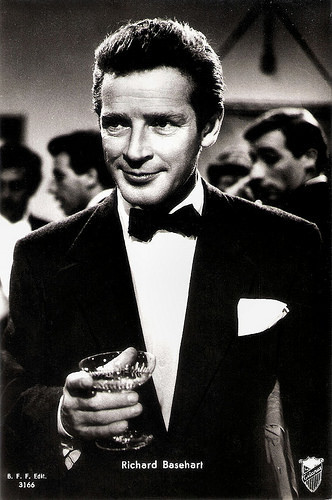
Italian postcard iby B.F.F. Edit., no. 3166. Photo: Titanus. Publicity still for Il Bidone (1955).
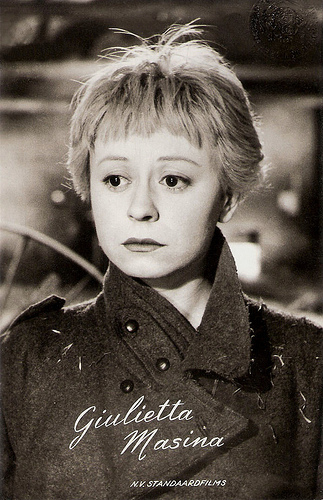
Giulietta Masina . Dutch postcard by Uitg. Takken, Utrecht, no. 3381. Photo: N.V. Standaardfilms. Publicity still for La strada (1954).
La Strada
John Richard Basehart was born in Zanesville, Ohio, U.S. in 1914. He spent a part of his childhood in an orphanage after the death of his mother, when his father, Harry Basehart, found himself unable to look after the four children left in his care. The younger Basehart considered a career in journalism like his father, but when he was 13, he began acting in small roles in a local theatre company and came to enjoy performing.
In the mid-'30s, he joined Jasper Deeter's famed Hedgerow Theater company in Rose Valley, PA. By the end of the 1930s, he'd set his sights on a Broadway career and moved to New York. During the 1939 season, while working in stock, Basehart met an actress named Stephanie Klein, and the two were married in early 1940. He continued trying to establish a foothold in New York and in 1942, joined Margaret Webster's theatre company. In 1945 director Bretaigne Windust cast him in the central role of the proud, dying young Scottish soldier in the play The Hasty Heart. Basehart won the 1945 New York Drama Critics Award for his performance and was named the most promising newcomer of the season.
In 1947, Basehart moved to Hollywood. He had his breakthrough as the killer in the gritty Film Noir He Walked by Night (Alfred L. Werker, Anthony Mann, 1948). Variety reviewed: “High-spot of the film is the final sequence which takes place in LA's storm drainage tunnel system where the killer tries to make his getaway. With this role, Basehart establishes himself as one of Hollywood's most talented finds in recent years. He heavily overshadows the rest of the cast, although Scott Brady, Roy Roberts and Jim Cardwell, as the detectives, deliver with high competence.”
Next Basehart played a psychotic member of the Hatfield clan in Roseanna McCoy (Irving Reis, 1949), starring Farley Granger . Then he appeared in the Film Noir Fourteen Hours (Henry Hathaway, 1951), as an unhappy man who threatens suicide by standing on the ledge of a high-rise building for 14 hours. During the filming, Basehart's wife Stephanie was taken ill with what proved to be a brain tumour, and died very suddenly. Devastated, he finished work on the film. Roles followed in the war drama Decision Before Dawn (Anatole Litvak, 1951) with Oskar Werner , and the Film Noir The House on Telegraph Hill (Robert Wise, 1951). He fell in love with his co-star in this film, Italian actress Valentina Cortese . They married and would have one son, actor Jackie Basehart.
In Italy, Richard Basehart played one of his most notable film roles, the acrobat known as ‘the Fool’ in the acclaimed Italian film drama La Strada (Federico Fellini, 1954). The film portrays a brutish strongman (Anthony Quinn) and the naïve young woman ( Giulietta Masina ) whom he buys from her mother and takes with him on the road; encounters with his rival the Fool (Richard Basehart) end with their destruction. The film premiered at the 15th Venice International Film Festival in 1954 and won the Silver Lion. In 1956, it won the inaugural Academy Award for Best Foreign Language Film. Basehart worked again with Fellini on Il bidone/The Swindlers (Federico Fellini, 1955) co-starring Broderick Crawford and Giulietta Masina. Il bidone continues with many of the same socially conscious, neorealist-inspired themes.
The next year, Basehart played Ishmael in Moby Dick (John Huston, 1956), the film adaptation of Herman Melville's novel Moby-Dick. In Spain, he made the comedy Los jueves, milagro/On Thursday, miracle (Luis García Berlanga, 1957), about some people in a small village who decide to fake a miracle in order to increase the tourism but things don't go as planned. He was also one of the brothers in The Brothers Karamazov (Richard Brooks, 1958), based on Fyodor Dostoevsky's novel. In 1960, Basehart and Valentina Cortese divorced. She had left him and moved back to Italy with their young son. For months Basehart had a standing phone call in to Italy, but Valentina never answered it.

Valentina Cortese . Italian postcard by Bromofoto, Milano, no. 399.
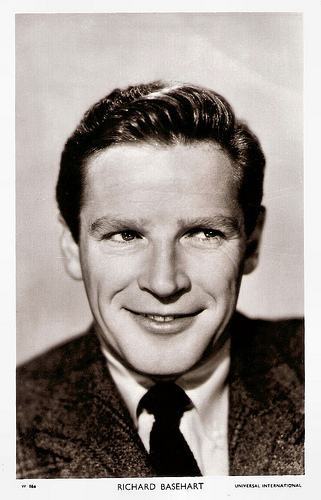
British postcard in the Picturegoer Series, London, no. W 884. Photo: Universal International.
Voyage to the Bottom of the Sea
Richard Basehart starred as Adolf Hitler in Hitler (Stuart Heisler, 1962). The film depicts Hitler through the years, beginning with the Beer Hall Putsch of November 1923 and focuses mainly on his private life, in particular, his relationships with niece Geli (Cordula Trantow) and long-time companion, Eva Braun ( Maria Emo ).
From 1964 to 1968, he played the lead role, Admiral Harriman Nelson, on Irwin Allen's first foray into science-fiction television, Voyage to the Bottom of the Sea. The 110 episodes produced included 32 shot in black-and-white (1964–1965), and 78 filmed in colour (1965–1968). The first two seasons took place in the then future of the 1970s. The final two seasons took place in the 1980s.
Basehart was noted for his deep, distinctive voice and narrated a wide range of television and film projects. In 1964, he narrated Four Days in November (Mel Stuart, 1964), about the assassination of John F. Kennedy. It was nominated for an Academy Award for Best Documentary Feature. In 1980, Basehart narrated the 26-part half-hour Canadian documentary series Vietnam: The Ten Thousand Day War (1980), written by Peter Arnett and produced by Michael Maclear. It covered Vietnam and its battles from the Japanese surrender on 2 September 1945 to the final American embassy evacuation on 30 April 1975.
Basehart appeared in the pilot episode of the television series Knight Rider (1980) as billionaire Wilton Knight, the creator of FLAG, who dies in the pilot episode. He is the narrator at the beginning of the show's credits. Basehart also played guest parts in popular TV series like The Twilight Zone (1963), Gunsmoke (1971), Columbo (1972), and Little House on the Prairie (1976). Later films include the drama Rage (George C. Scott, 1972), the Science Fiction film The Island of Dr. Moreau (Don Taylor, 1977) starring Burt Lancaster , and the acclaimed comedy-drama Being There (Hal Ashby, 1979) with Peter Sellers.
Basehart was married three times. His first wife was Stephanie Klein (1940-1950; her death). After his divorce from Valentina Cortese , Basehart married Diana Lotery (1962-1984; his death), with whom he had two children, including make-up artist Gayle Basehart. The couple founded the charity Actors and Others for Animals, after they saw a small dog get thrown from a fast-moving vehicle on a Los Angeles freeway.
Richard Basehart died at age 70 in Los Angeles, following a series of strokes. One month before his death, Basehart was an announcer for the closing ceremonies of the 1984 Summer Olympics in Los Angeles. He is buried at Westwood Village Memorial Park Cemetery in Los Angeles. Bruce Eder at AllMovie : “Richard Basehart was too much of an actor (and almost too good an actor) to ever be a movie star -- his range was sufficient to allow him to play murderers, psychopaths, sociopaths, and would-be suicides in 20 years' worth of theatrical films in totally convincing fashion, but also to portray a hero in the longest-running science fiction/adventure series on network television. Without ever achieving stardom, he became one of the most respected performers of his generation.”
Trailer Fourteen Hours (1951). Source: captainbijou.com (YouTube).
Trailer La Strada (1954). Source: MrAris67 (YouTube).
Sources: Bruce Eder (AllMovie), Wikipedia, and .

Italian postcard iby B.F.F. Edit., no. 3166. Photo: Titanus. Publicity still for Il Bidone (1955).

Giulietta Masina . Dutch postcard by Uitg. Takken, Utrecht, no. 3381. Photo: N.V. Standaardfilms. Publicity still for La strada (1954).
La Strada
John Richard Basehart was born in Zanesville, Ohio, U.S. in 1914. He spent a part of his childhood in an orphanage after the death of his mother, when his father, Harry Basehart, found himself unable to look after the four children left in his care. The younger Basehart considered a career in journalism like his father, but when he was 13, he began acting in small roles in a local theatre company and came to enjoy performing.
In the mid-'30s, he joined Jasper Deeter's famed Hedgerow Theater company in Rose Valley, PA. By the end of the 1930s, he'd set his sights on a Broadway career and moved to New York. During the 1939 season, while working in stock, Basehart met an actress named Stephanie Klein, and the two were married in early 1940. He continued trying to establish a foothold in New York and in 1942, joined Margaret Webster's theatre company. In 1945 director Bretaigne Windust cast him in the central role of the proud, dying young Scottish soldier in the play The Hasty Heart. Basehart won the 1945 New York Drama Critics Award for his performance and was named the most promising newcomer of the season.
In 1947, Basehart moved to Hollywood. He had his breakthrough as the killer in the gritty Film Noir He Walked by Night (Alfred L. Werker, Anthony Mann, 1948). Variety reviewed: “High-spot of the film is the final sequence which takes place in LA's storm drainage tunnel system where the killer tries to make his getaway. With this role, Basehart establishes himself as one of Hollywood's most talented finds in recent years. He heavily overshadows the rest of the cast, although Scott Brady, Roy Roberts and Jim Cardwell, as the detectives, deliver with high competence.”
Next Basehart played a psychotic member of the Hatfield clan in Roseanna McCoy (Irving Reis, 1949), starring Farley Granger . Then he appeared in the Film Noir Fourteen Hours (Henry Hathaway, 1951), as an unhappy man who threatens suicide by standing on the ledge of a high-rise building for 14 hours. During the filming, Basehart's wife Stephanie was taken ill with what proved to be a brain tumour, and died very suddenly. Devastated, he finished work on the film. Roles followed in the war drama Decision Before Dawn (Anatole Litvak, 1951) with Oskar Werner , and the Film Noir The House on Telegraph Hill (Robert Wise, 1951). He fell in love with his co-star in this film, Italian actress Valentina Cortese . They married and would have one son, actor Jackie Basehart.
In Italy, Richard Basehart played one of his most notable film roles, the acrobat known as ‘the Fool’ in the acclaimed Italian film drama La Strada (Federico Fellini, 1954). The film portrays a brutish strongman (Anthony Quinn) and the naïve young woman ( Giulietta Masina ) whom he buys from her mother and takes with him on the road; encounters with his rival the Fool (Richard Basehart) end with their destruction. The film premiered at the 15th Venice International Film Festival in 1954 and won the Silver Lion. In 1956, it won the inaugural Academy Award for Best Foreign Language Film. Basehart worked again with Fellini on Il bidone/The Swindlers (Federico Fellini, 1955) co-starring Broderick Crawford and Giulietta Masina. Il bidone continues with many of the same socially conscious, neorealist-inspired themes.
The next year, Basehart played Ishmael in Moby Dick (John Huston, 1956), the film adaptation of Herman Melville's novel Moby-Dick. In Spain, he made the comedy Los jueves, milagro/On Thursday, miracle (Luis García Berlanga, 1957), about some people in a small village who decide to fake a miracle in order to increase the tourism but things don't go as planned. He was also one of the brothers in The Brothers Karamazov (Richard Brooks, 1958), based on Fyodor Dostoevsky's novel. In 1960, Basehart and Valentina Cortese divorced. She had left him and moved back to Italy with their young son. For months Basehart had a standing phone call in to Italy, but Valentina never answered it.

Valentina Cortese . Italian postcard by Bromofoto, Milano, no. 399.

British postcard in the Picturegoer Series, London, no. W 884. Photo: Universal International.
Voyage to the Bottom of the Sea
Richard Basehart starred as Adolf Hitler in Hitler (Stuart Heisler, 1962). The film depicts Hitler through the years, beginning with the Beer Hall Putsch of November 1923 and focuses mainly on his private life, in particular, his relationships with niece Geli (Cordula Trantow) and long-time companion, Eva Braun ( Maria Emo ).
From 1964 to 1968, he played the lead role, Admiral Harriman Nelson, on Irwin Allen's first foray into science-fiction television, Voyage to the Bottom of the Sea. The 110 episodes produced included 32 shot in black-and-white (1964–1965), and 78 filmed in colour (1965–1968). The first two seasons took place in the then future of the 1970s. The final two seasons took place in the 1980s.
Basehart was noted for his deep, distinctive voice and narrated a wide range of television and film projects. In 1964, he narrated Four Days in November (Mel Stuart, 1964), about the assassination of John F. Kennedy. It was nominated for an Academy Award for Best Documentary Feature. In 1980, Basehart narrated the 26-part half-hour Canadian documentary series Vietnam: The Ten Thousand Day War (1980), written by Peter Arnett and produced by Michael Maclear. It covered Vietnam and its battles from the Japanese surrender on 2 September 1945 to the final American embassy evacuation on 30 April 1975.
Basehart appeared in the pilot episode of the television series Knight Rider (1980) as billionaire Wilton Knight, the creator of FLAG, who dies in the pilot episode. He is the narrator at the beginning of the show's credits. Basehart also played guest parts in popular TV series like The Twilight Zone (1963), Gunsmoke (1971), Columbo (1972), and Little House on the Prairie (1976). Later films include the drama Rage (George C. Scott, 1972), the Science Fiction film The Island of Dr. Moreau (Don Taylor, 1977) starring Burt Lancaster , and the acclaimed comedy-drama Being There (Hal Ashby, 1979) with Peter Sellers.
Basehart was married three times. His first wife was Stephanie Klein (1940-1950; her death). After his divorce from Valentina Cortese , Basehart married Diana Lotery (1962-1984; his death), with whom he had two children, including make-up artist Gayle Basehart. The couple founded the charity Actors and Others for Animals, after they saw a small dog get thrown from a fast-moving vehicle on a Los Angeles freeway.
Richard Basehart died at age 70 in Los Angeles, following a series of strokes. One month before his death, Basehart was an announcer for the closing ceremonies of the 1984 Summer Olympics in Los Angeles. He is buried at Westwood Village Memorial Park Cemetery in Los Angeles. Bruce Eder at AllMovie : “Richard Basehart was too much of an actor (and almost too good an actor) to ever be a movie star -- his range was sufficient to allow him to play murderers, psychopaths, sociopaths, and would-be suicides in 20 years' worth of theatrical films in totally convincing fashion, but also to portray a hero in the longest-running science fiction/adventure series on network television. Without ever achieving stardom, he became one of the most respected performers of his generation.”
Trailer Fourteen Hours (1951). Source: captainbijou.com (YouTube).
Trailer La Strada (1954). Source: MrAris67 (YouTube).
Sources: Bruce Eder (AllMovie), Wikipedia, and .
Published on September 15, 2015 22:00
September 14, 2015
Twelve more rare postcards from Didier Hanson's collection
Last week, at 8 September, we posted twelve rare, vintage postcards, recently acquired by collector Didier Hanson. We promised you a follow-up while Didier sent us several other interesting scans. Today a post on twelve more a-century-old postcards including a series made for that enigmatic German production Das Mirakel/The Miracle (Cherry Kearton, Max Reinhardt, 1912) starring the Italian diva Maria Carmi as the Madonna. We end this post with four cards of beautiful Vera Kholodnaya, the ‘Queen of Screen’ of the Russian Empire.
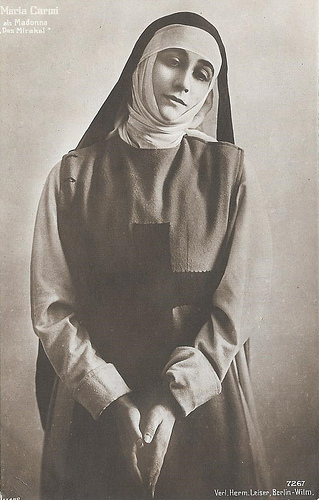
German postcard by Verleih Hermann Leiser, Berlin-Wilmersdorf, no. 7267. Publicity still for Das Mirakel/The Miracle (Cherry Kearton, Max Reinhardt, 1912). Collection: Didier Hanson.
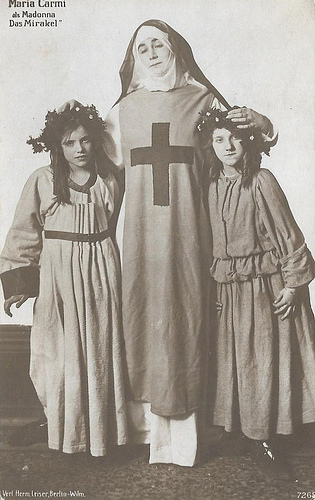
German postcard by Verleih Hermann Leiser, Berlin-Wilmersdorf, no. 7268. Publicity still for Das Mirakel/The Miracle (Cherry Kearton, Max Reinhardt, 1912). Collection: Didier Hanson.
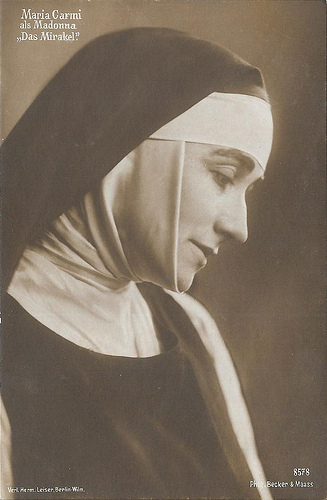
German postcard by Verleih Hermann Leiser, Berlin-Wilmersdorf, no. 8578. Photo: Becker & Maass. Publicity still for Das Mirakel/The Miracle (Cherry Kearton, Max Reinhardt, 1912). Collection: Didier Hanson.
Carmi Meets Reinhardt
With her aristocratic air, her severe looks but also her sweet undertones, Italian silent film star and stage actress Maria Carmi (1880-1957) was the cinematic translation of the 19th century Primadonna.
Carmi was born Norina Gilli in Firenze (Florence), Italy, in 1880. When she married German comedy writer Karl Volmöller she moved to Berlin, where she attended Max Reinhardt's acting school at the Deutsches Theater. She belonged to his company from 1907 to 1909 and used the stage name Maria Carmi .
In 1911, Reinhardt asked her for the pantomime play Das Mirakel/The Miracle written by her husband, Karl Vollmöller. The religious pantomime was originally produced in Germany in 1911 and opened in London on 23 December 1911. Over the years she would give over 1,000 performances of the play.
The next year it was turned into a film, Das Mirakel/The Miracle (Cherry Kearton, Max Reinhardt, 1912). She also appeared in Reinhardts film Eine Venezianische Nacht/A Venetian Night (Max Reinhardt, 1914) with Alfred Abel.
In 1917 Maria Carmi became Princess Norina Matchabelli and in 1924, she and her husband founded the perfume company Prince Matchabelli.
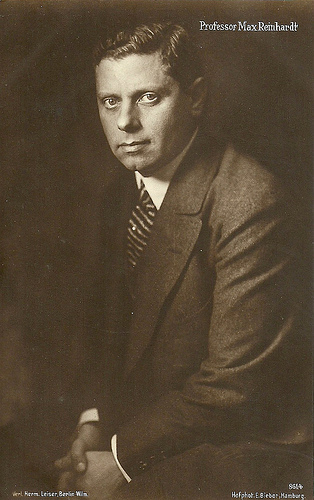
German postcard by Verlag Hermann Leiser, Berlin, no. 8614, 1916. Photo: Hofphot. E. Bieber, Hamburg. Collection: Didier Hanson.
German actor-director Max Reinhardt (1873-1943) was one of the great innovators of the theatre. He also directed several films, including Sumurûn (1910) and Das Mirakel (1912). In 1934, he went into exile and made in Hollywood A Midsummer Night's Dream (1935).
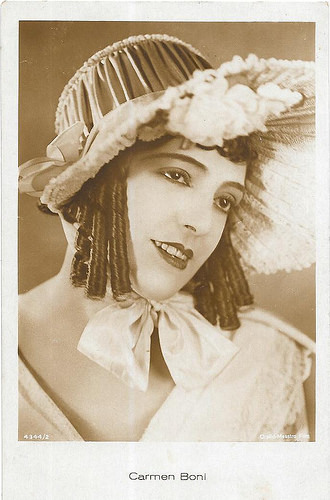
French postcard. Photo: G.L. Manuel Frères. Collection: Didier Hanson.
Italian silent film star Carmen Boni (1901-1963) had a successful career in the Italian cinema of the early 1920s, before moving to Germany where she made one film after another in the late 1920s.
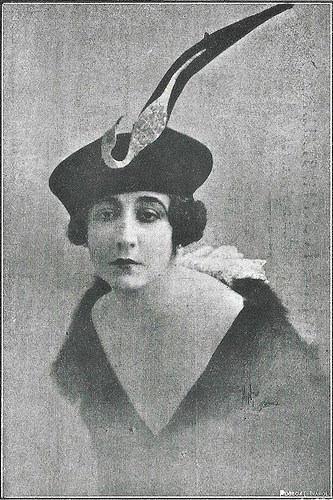
Italian postcard. Photo: Robeo & Co, Napoli (?), Collection: Didier Hanson.
Film diva Leda Gys (1892-1957) starred in ca. 60 dramas, comedies, action thrillers and even westerns of the Italian and Spanish silent cinema. Her claim to fame came with the film Christus (1916), shot in Egypt and Palestine, where Gys performed the Madonna.
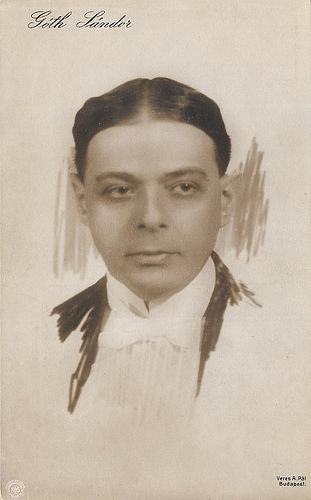
Hungarian postcard. Photo: Pál A. Veres, Budapest. Collection: Didier Hanson.
Hungarian actor and director Sándor Góth (1869-1946) was one of the great pioneers of the Hungarian cinema. During the 1910s, he directed a series of short films for the Hunnia Biográf company, in a style strongly influenced by the stage. In Paris, he appeared in two Hungarian language versions of Paramount films, Az orvos titka/The Doctor's Secret (Tibor Hegedüs, 1930), and Kacagó asszony/The Laughing Lady (Tibor Hegedüs, 1930), which in fact marked the start of Hungarian sound film. As an actor, he was the unparalleled artist of the conversation style. He was characterised by his excellent ability to form characters and to make parodies. Between 1931-39 he taught at the School for Dramatic Arts. One of his books is the interesting Ha Moliere naplót írt volna (1946).
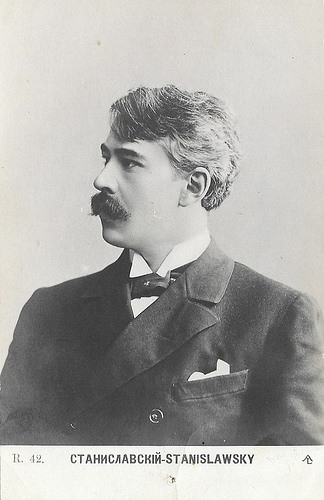
Russian postcard, no. R 42. Collection: Didier Hanson.
Constantin Sergeievich Stanislavsky (Константи́н Серге́евич Станисла́вский) (1863–1938) was a Russian actor and theatre director. The eponymous Stanislavsky method, or simply 'method acting', has had a pervasive influence on the American theatre and cinema, especially in the period after World War II.
The first star of the Russian silent cinema
Didier can't get enough of her, and neither can we: Vera Kholodnaya (1893-1919), so beautiful, so tragic.
Although she worked only three years for the cinema, she must have made between fifty and hundred short films.
Only 26, the ‘Queen of Screen’ died of the Spanish flu during the pandemic of 1919. Five years later the Soviet authorities ordered to destroy many of the Kholodnaya features.
Only five of Kholodnaya's films still exist. But, thanks to Didier, there are now dozens of her postcards online. To remember her.
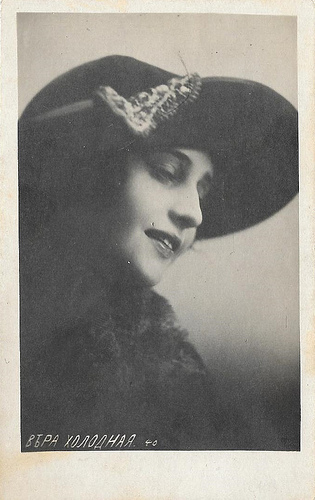
Russian postcard, no. 40. Collection: Didier Hanson.
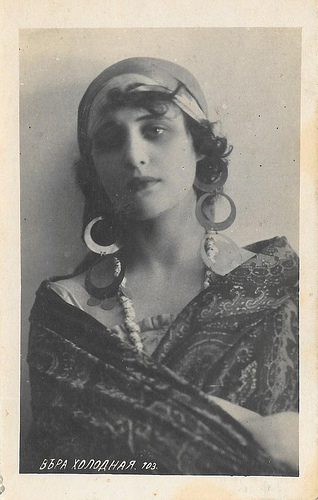
Russian postcard, no. 103. Collection: Didier Hanson.
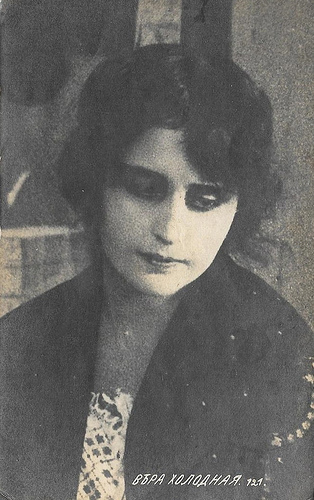
Russian postcard, no. 121. Collection: Didier Hanson.
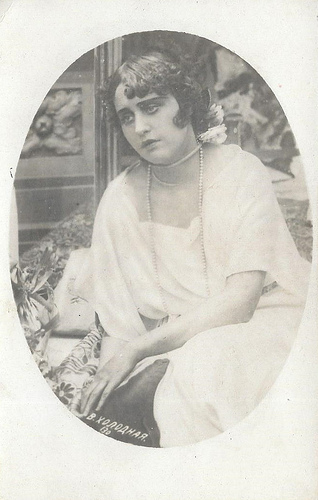
Russian postcard, no. 130. Collection: Didier Hanson.
Thanks, Didier!

German postcard by Verleih Hermann Leiser, Berlin-Wilmersdorf, no. 7267. Publicity still for Das Mirakel/The Miracle (Cherry Kearton, Max Reinhardt, 1912). Collection: Didier Hanson.

German postcard by Verleih Hermann Leiser, Berlin-Wilmersdorf, no. 7268. Publicity still for Das Mirakel/The Miracle (Cherry Kearton, Max Reinhardt, 1912). Collection: Didier Hanson.

German postcard by Verleih Hermann Leiser, Berlin-Wilmersdorf, no. 8578. Photo: Becker & Maass. Publicity still for Das Mirakel/The Miracle (Cherry Kearton, Max Reinhardt, 1912). Collection: Didier Hanson.
Carmi Meets Reinhardt
With her aristocratic air, her severe looks but also her sweet undertones, Italian silent film star and stage actress Maria Carmi (1880-1957) was the cinematic translation of the 19th century Primadonna.
Carmi was born Norina Gilli in Firenze (Florence), Italy, in 1880. When she married German comedy writer Karl Volmöller she moved to Berlin, where she attended Max Reinhardt's acting school at the Deutsches Theater. She belonged to his company from 1907 to 1909 and used the stage name Maria Carmi .
In 1911, Reinhardt asked her for the pantomime play Das Mirakel/The Miracle written by her husband, Karl Vollmöller. The religious pantomime was originally produced in Germany in 1911 and opened in London on 23 December 1911. Over the years she would give over 1,000 performances of the play.
The next year it was turned into a film, Das Mirakel/The Miracle (Cherry Kearton, Max Reinhardt, 1912). She also appeared in Reinhardts film Eine Venezianische Nacht/A Venetian Night (Max Reinhardt, 1914) with Alfred Abel.
In 1917 Maria Carmi became Princess Norina Matchabelli and in 1924, she and her husband founded the perfume company Prince Matchabelli.

German postcard by Verlag Hermann Leiser, Berlin, no. 8614, 1916. Photo: Hofphot. E. Bieber, Hamburg. Collection: Didier Hanson.
German actor-director Max Reinhardt (1873-1943) was one of the great innovators of the theatre. He also directed several films, including Sumurûn (1910) and Das Mirakel (1912). In 1934, he went into exile and made in Hollywood A Midsummer Night's Dream (1935).

French postcard. Photo: G.L. Manuel Frères. Collection: Didier Hanson.
Italian silent film star Carmen Boni (1901-1963) had a successful career in the Italian cinema of the early 1920s, before moving to Germany where she made one film after another in the late 1920s.

Italian postcard. Photo: Robeo & Co, Napoli (?), Collection: Didier Hanson.
Film diva Leda Gys (1892-1957) starred in ca. 60 dramas, comedies, action thrillers and even westerns of the Italian and Spanish silent cinema. Her claim to fame came with the film Christus (1916), shot in Egypt and Palestine, where Gys performed the Madonna.

Hungarian postcard. Photo: Pál A. Veres, Budapest. Collection: Didier Hanson.
Hungarian actor and director Sándor Góth (1869-1946) was one of the great pioneers of the Hungarian cinema. During the 1910s, he directed a series of short films for the Hunnia Biográf company, in a style strongly influenced by the stage. In Paris, he appeared in two Hungarian language versions of Paramount films, Az orvos titka/The Doctor's Secret (Tibor Hegedüs, 1930), and Kacagó asszony/The Laughing Lady (Tibor Hegedüs, 1930), which in fact marked the start of Hungarian sound film. As an actor, he was the unparalleled artist of the conversation style. He was characterised by his excellent ability to form characters and to make parodies. Between 1931-39 he taught at the School for Dramatic Arts. One of his books is the interesting Ha Moliere naplót írt volna (1946).

Russian postcard, no. R 42. Collection: Didier Hanson.
Constantin Sergeievich Stanislavsky (Константи́н Серге́евич Станисла́вский) (1863–1938) was a Russian actor and theatre director. The eponymous Stanislavsky method, or simply 'method acting', has had a pervasive influence on the American theatre and cinema, especially in the period after World War II.
The first star of the Russian silent cinema
Didier can't get enough of her, and neither can we: Vera Kholodnaya (1893-1919), so beautiful, so tragic.
Although she worked only three years for the cinema, she must have made between fifty and hundred short films.
Only 26, the ‘Queen of Screen’ died of the Spanish flu during the pandemic of 1919. Five years later the Soviet authorities ordered to destroy many of the Kholodnaya features.
Only five of Kholodnaya's films still exist. But, thanks to Didier, there are now dozens of her postcards online. To remember her.

Russian postcard, no. 40. Collection: Didier Hanson.

Russian postcard, no. 103. Collection: Didier Hanson.

Russian postcard, no. 121. Collection: Didier Hanson.

Russian postcard, no. 130. Collection: Didier Hanson.
Thanks, Didier!
Published on September 14, 2015 22:00
September 13, 2015
Our Gang's Jean Darling and Dickie Moore R.I.P.
Recently two of the 'Little Rascals' of the Our Gang comedies have died. On 4 September 2015, Blonde Jean Darling (1922-2015) passed away at 93. She was, along with Baby Peggy, one of the last surviving actors who worked in the silent film era. Three days later, she was followed by Dickie Moore (1925-2015), who died at the age of 89.
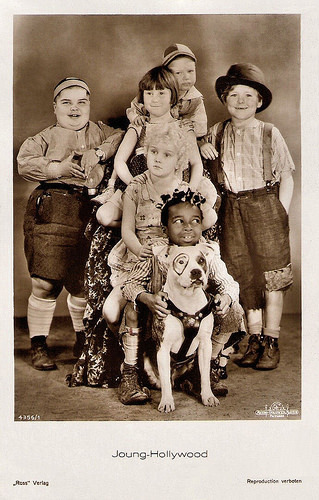
German postcard by Ross Verlag, no. 4356/1, 1929-1930. Photo: Metro-Goldwyn-Mayer. Publicity still of Our Gang with Jean Darling as the blonde girl.
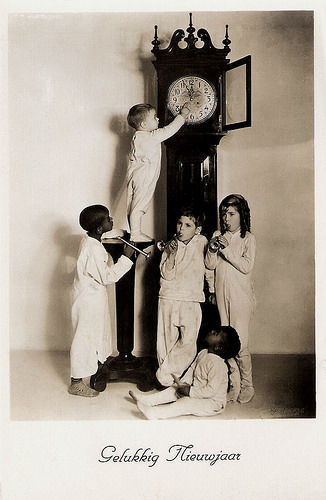
Dutch postcard. Photo: a publicity shot of the Little Rascals a.k.a. Our Gang with Dickie Moore in the middle. Caption: "Gelukkig Nieuwjaar" (Happy New Year).
Jean Darling
Jean Darling was born as Dorothy Jean LeVake in 1922. Her name was legally changed to Jean Darling when she was five months old, a few days after her mother and father split. At six months old she started her screen career during the silent era as a freelance baby.
She got her break in 1926 when she passed a screen test and was accepted for a part in Hal Roach's Our Gang series. Darling appeared in 46 silents and six talkies with Our Gang during this period.
Our Gang, also known as The Little Rascals, is a series of American comedy short films about a group of poor neighbourhood children and their adventures. Created by comedy producer Hal Roach, the series is noted for showing children behaving in a relatively natural way, as Roach and original director Robert F. McGowan worked to film the unaffected, raw nuances apparent in regular children rather than have them imitate adult acting styles. In addition, Our Gang notably put boys, girls, whites and blacks together as equals.
The franchise began in 1922 as a series of silent short subjects produced by the Roach studio and released by Pathé Exchange. Roach changed distributors from Pathé to Metro-Goldwyn-Mayer (MGM) in 1927, and the series entered its most popular period after converting to sound in 1929.
Jean Darling played in the Little Rascals shorts till 1929. Later she appeared with Laurel & Hardy in a bit role in Babes in Toyland (Gus Meins, Charley Rogers, 1934) and as the young Jane in Jane Eyre (Christy Cabanne, 1934).
Having toured the world with husband, Kajar the Magician's Show Magicadabr, Jean Darling settled in Dublin and became an author of dozens of short mysteries and horror fantasy for magazines. In 1980 she became Aunty Poppy writing and telling over 450 children's stories on both RTE radio and TV.
Prior to her death, she was one of four surviving cast members from the silent era cast of Our Gang. The others are Lassie Lou Ahern, Mildred Kornman and Dorothy Morrison.
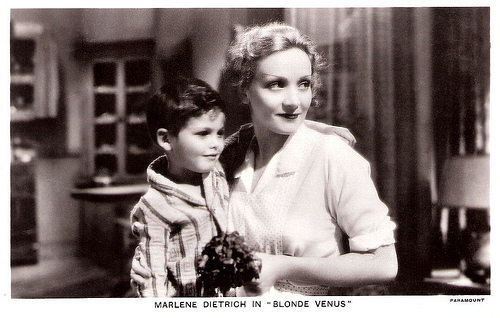
British postcard, distributed in the Netherlands by M. Bonnist & Zonen, Amsterdam, no, 136e. Photo: Paramount. Publicity still of Marlene Dietrich and Dickie Moore in Blonde Venus (Josef von Sternberg, 1932).
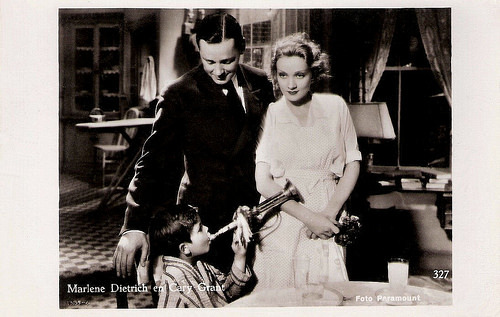
Dutch postcard by JosPe, no. 327, ca. 1932. Photo: Paramount. Publicity still of Marlene Dietrich , Herbert Marshall (and not Cary Grant as credited!) and Dickie Moore in Blonde Venus (Josef von Sternberg, 1932).
Dickie Moore
Dickie Moore already made his screen debut as a baby in the John Barrymore film The Beloved Rogue (1927).
He played the little son of Marlene Dietrich in Blonde Venus (Josef von Sternberg, 1932) and then was one of the regulars in the Our Gang comedies for a year (1932-1933).
By the time he had turned 10, he was a popular child star and had appeared in 52 films. Later, he gave 14-year-old Shirley Temple her first screen kiss - in Miss Annie Rooney (Edwin L. Marin, 1942). Then the roles began to dry up, and he made his last film in 1950.
Moore worked as a public-relations executive and produced industrial shows. He was the Author of Twinkle, Twinkle Little Star (But Don't Have Sex or Take the Car) in which he interviewed 31 ex-child actors, more than half of whom found their adult lives beset by alcoholism, nervous breakdowns, or failed first marriages.
Besides his his third and last wife, film actress Jane Powell, Moore is survived by a son, Kevin; a stepson, Geary; two stepdaughters, Lindsay and Suzanne; a sister, Pat Kingsley; and several grandchildren and step-grandchildren.
And how ended Our Gang on screen? Production of the series continued at the Hal Roach studio until 1938. Then the series was sold to MGM, which produced the comedies itself until 1944. In total, the Our Gang series includes 220 shorts and one feature film, General Spanky, featuring over forty-one child actors.
The Spanking Age (1928) with Jean Darling as the 'thirty-five pound pain-in-the-neck'. Source: OldNick08 (YouTube).
Free Wheeling (1932) with Dickie Moore. Source: Our Gang-Little Rascals Classics (YouTube).
Sources: and Wikipedia.

German postcard by Ross Verlag, no. 4356/1, 1929-1930. Photo: Metro-Goldwyn-Mayer. Publicity still of Our Gang with Jean Darling as the blonde girl.

Dutch postcard. Photo: a publicity shot of the Little Rascals a.k.a. Our Gang with Dickie Moore in the middle. Caption: "Gelukkig Nieuwjaar" (Happy New Year).
Jean Darling
Jean Darling was born as Dorothy Jean LeVake in 1922. Her name was legally changed to Jean Darling when she was five months old, a few days after her mother and father split. At six months old she started her screen career during the silent era as a freelance baby.
She got her break in 1926 when she passed a screen test and was accepted for a part in Hal Roach's Our Gang series. Darling appeared in 46 silents and six talkies with Our Gang during this period.
Our Gang, also known as The Little Rascals, is a series of American comedy short films about a group of poor neighbourhood children and their adventures. Created by comedy producer Hal Roach, the series is noted for showing children behaving in a relatively natural way, as Roach and original director Robert F. McGowan worked to film the unaffected, raw nuances apparent in regular children rather than have them imitate adult acting styles. In addition, Our Gang notably put boys, girls, whites and blacks together as equals.
The franchise began in 1922 as a series of silent short subjects produced by the Roach studio and released by Pathé Exchange. Roach changed distributors from Pathé to Metro-Goldwyn-Mayer (MGM) in 1927, and the series entered its most popular period after converting to sound in 1929.
Jean Darling played in the Little Rascals shorts till 1929. Later she appeared with Laurel & Hardy in a bit role in Babes in Toyland (Gus Meins, Charley Rogers, 1934) and as the young Jane in Jane Eyre (Christy Cabanne, 1934).
Having toured the world with husband, Kajar the Magician's Show Magicadabr, Jean Darling settled in Dublin and became an author of dozens of short mysteries and horror fantasy for magazines. In 1980 she became Aunty Poppy writing and telling over 450 children's stories on both RTE radio and TV.
Prior to her death, she was one of four surviving cast members from the silent era cast of Our Gang. The others are Lassie Lou Ahern, Mildred Kornman and Dorothy Morrison.

British postcard, distributed in the Netherlands by M. Bonnist & Zonen, Amsterdam, no, 136e. Photo: Paramount. Publicity still of Marlene Dietrich and Dickie Moore in Blonde Venus (Josef von Sternberg, 1932).

Dutch postcard by JosPe, no. 327, ca. 1932. Photo: Paramount. Publicity still of Marlene Dietrich , Herbert Marshall (and not Cary Grant as credited!) and Dickie Moore in Blonde Venus (Josef von Sternberg, 1932).
Dickie Moore
Dickie Moore already made his screen debut as a baby in the John Barrymore film The Beloved Rogue (1927).
He played the little son of Marlene Dietrich in Blonde Venus (Josef von Sternberg, 1932) and then was one of the regulars in the Our Gang comedies for a year (1932-1933).
By the time he had turned 10, he was a popular child star and had appeared in 52 films. Later, he gave 14-year-old Shirley Temple her first screen kiss - in Miss Annie Rooney (Edwin L. Marin, 1942). Then the roles began to dry up, and he made his last film in 1950.
Moore worked as a public-relations executive and produced industrial shows. He was the Author of Twinkle, Twinkle Little Star (But Don't Have Sex or Take the Car) in which he interviewed 31 ex-child actors, more than half of whom found their adult lives beset by alcoholism, nervous breakdowns, or failed first marriages.
Besides his his third and last wife, film actress Jane Powell, Moore is survived by a son, Kevin; a stepson, Geary; two stepdaughters, Lindsay and Suzanne; a sister, Pat Kingsley; and several grandchildren and step-grandchildren.
And how ended Our Gang on screen? Production of the series continued at the Hal Roach studio until 1938. Then the series was sold to MGM, which produced the comedies itself until 1944. In total, the Our Gang series includes 220 shorts and one feature film, General Spanky, featuring over forty-one child actors.
The Spanking Age (1928) with Jean Darling as the 'thirty-five pound pain-in-the-neck'. Source: OldNick08 (YouTube).
Free Wheeling (1932) with Dickie Moore. Source: Our Gang-Little Rascals Classics (YouTube).
Sources: and Wikipedia.
Published on September 13, 2015 22:00
September 12, 2015
Franco Interlenghi RIP (1931-2015)
On 10 September, Italian actor Franco Interlenghi (1930-2015) has passed away. He was a popular leading man during the 1950s and worked with major directors like De Sica, Fellini, Antonioni, Bolognini and Rossellini. Although Interlenghi never gained international stardom, he was just as revered in his country as Marcello Mastroianni. Interlenghi was 83.
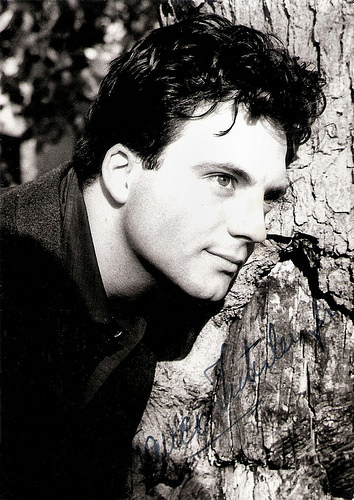
Italian autograph card. Signed in 1958.
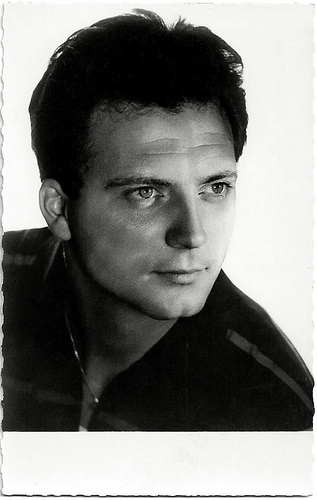
French postcard. Photo: Sam Lévin.
Shoe-Shine
Franco Interlenghi was born in Rome, Italy in 1931 (some sources say 1930).
At 15 years old, he made his film debut in a classic of the Italian neorealist cinema, Sciuscià/Shoeshine (Vittorio De Sica, 1946). De Sica used nonprofessional actors, and he painted an uncompromising picture of the lives of Italian street children abandoned by their parents at the end of World War II. The film concentrates on two such children, Giuseppe (Rinaldo Smerdoni) and Pasquale (Franco Interlenghi). With no one else to turn to, the boys form a solid friendship, as well as a ‘corporation’ of sorts: they eke out a living shining the boots of American GI’s.
At AllMovie , Hal Erickson calls Sciuscia 'a must-see example of Italian neorealist cinema': "A failure in Italy (director Vittorio De Sica noted that postwar Italian audiences preferred the glossy escapism emanating from Hollywood), Shoeshine was a huge success worldwide, as well as the winner of a special Academy Award. Like Bicycle Thieves, it combines De Sica's frequent focus on children with his emphasis on post-war social problems."
In the following years, young Franco appeared in more successful films like the historical epic Fabiola (Alessandro Blasetti, 1949) starring Michèle Morgan , the neorealist comedy Domenica d'agosto/A Sunday in August (Luciano Emmer, 1950), the comedy classic Don Camillo/The Little World of Don Camillo (Julien Duvivier, 1952) featuring Fernandel , the murder drama Processo alla città/The City Stands Trial (Luigi Zampa, 1952), and the Homer adaptation Ulisse/Ulysses (Mario Camerini, 1954) starring Kirk Douglas and Silvana Mangano .
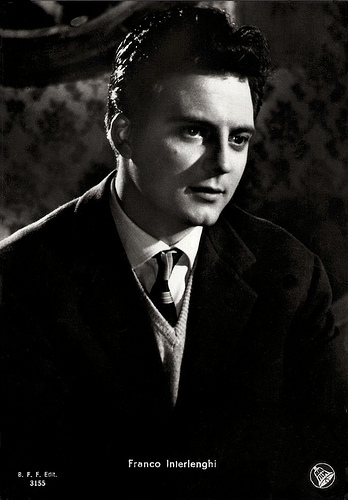
Italian postcard by Casa Edite. Ballerini & Fratini, Firenze, no. 3155. Photo: Dear Film.
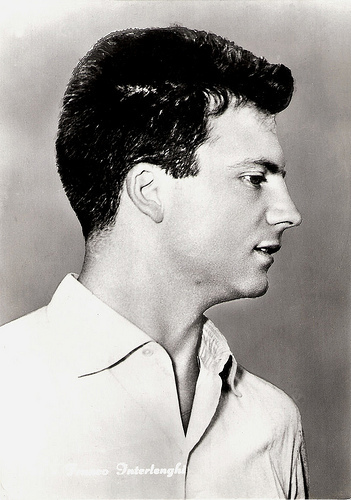
Italian postcard by Turismofoto.
Layabouts
Franco Interlenghi is probably best remembered for his leading role in Federico Fellini’s beautiful I Vitelloni/Spivs (1953). I Vitelloni follows the lives of five young vitelloni, or layabouts, who while away their listless days in their small seaside village. While the film seems to pay little attention to Moraldo (Interlenghi), he eventually emerges as its key character, plainly serving as Fellini's alter ego.
Franco Interlenghi worked that same year with another maestro, Michelangelo Antonioni, at I Vinti/The Vanquished (1953), a triptych film featuring three murders in London, Paris and Rome.
Interlenghi appeared in supporting parts in several Hollywood productions filmed on location in Italy, like Teresa (Fred Zinnemann, 1951) with Pier Angeli , The Barefoot Contessa (Joseph L. Mankiewicz, 1954) starring Ava Gardner and Humphrey Bogart, and A Farewell to Arms (Charles Vidor, who replaced John Huston, 1957) with Rock Hudson.
In France, he starred opposite Brigitte Bardot and Jean Gabin in En Cas de malheur/Love is My Profession (Claude Autant-Lara, 1958).
Among his well known Italian films of the 1950s were also Gli Innamorati/Wild Love (Mauro Bolognini, 1955) with his wife Antonella Lualdi , the comedy Totò, Peppino e i... fuorilegge/Totò, Peppino and the Outlaw (Camillo Mastrocinque, 1956) starring comedians Totò and Peppino de Filippo , the comedy Padri e figli/Like Father, Like Son (Mario Monicelli, 1957), the war drama Il generale della Rovere/General della Rovere (Roberto Rossellini, 1959) featuring Vittorio De Sica , and the crime drama La notte brava/Bad Girls Don’t Cry (Mauro Bolognini, 1959), again opposite Antonella Lualdi .
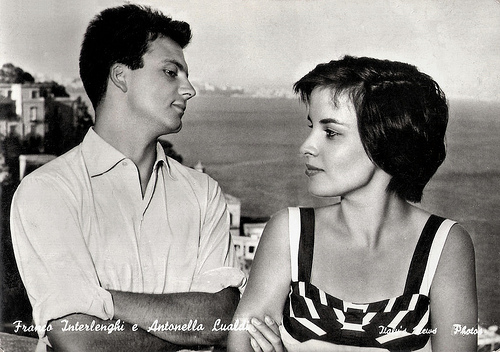
With Antonella Lualdi. Italian postcard by Bromofoto, Milano, no. 1234. Photo: Italy's News Photos.
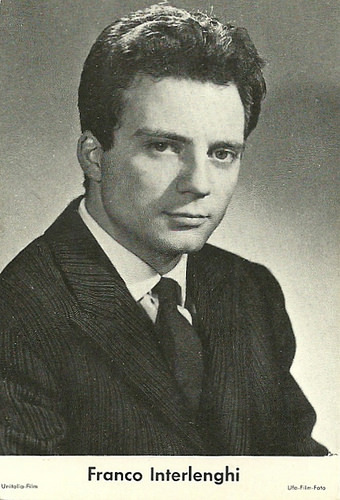
German minicard by Ufa-Film-Foto. Photo: Unitalia-Film.
Sexploitation
Although Franco Interlenghi would never gain international stardom, he was a popular film actor in his home country. In addition to films, he also appeared in successful theatrical productions. He worked with famous director Luchino Visconti on an adaptation of Death of a salesman.
In the 1960s and 1970s, he appeared less often for the cinema. His films from this period include the historical drama Viva l'Italia!/Garibaldi (Roberto Rossellini, 1961), the crime film Mise a Sac/Pillaged (Alain Cavalier, 1967), the historical romance Columna/The Column (Mircea Dragan, 1968), and the Western Amore, piombo e furore/China 9, Liberty 37 (Monte Hellmann, 1978) with Fabio Testi and Warren Oates.
In the following decades he was seen more regularly in films and also on TV. His roles were however smaller and the films less successful than during the 1950s. He appeared in supporting parts in the crime drama Il Camorrista/The Professor (Giuseppe Tornatore, 1986) starring Ben Gazzara, the Molière adaptation L’avare/The Miser (Tonino Cervi, 1990) starring Alberto Sordi , the psychological thriller L’ours en peluche/The Teddybear (Jacques Deray, 1994) with Alain Delon , and the drama Marciando Nel Buio/Marching in the dark (Massimo Spano, 1995), about the brutal rape of a young soldier and his attempts to bring the culprit to justice. He also appeared in a sexploitation film by Tinto Brass, Miranda (Tinto Brass, 1985).
More recent films were the sweeping crime drama Romanzo Criminale/Crime Novel (Michele Placido, 2005) starring Kim Rossi Stuart, and the comedy sequel Notte prima degli esami – Oggi/The Night Before the Exams - Today (Fausto Brizzi, 2007).
When he died, Franco Interlenghi was still married to Antonella Lualdi . They had married in 1955 and their marriage was one of the happiest in the Italian film community. Both their daughter, Antonellina Interlenghi and their granddaughter, Virginia Sanjust Di Teulada are actors too. Franco Interlenghi was 83.
Trailer Sciuscià/Shoeshine (1946). Source: Umbrella Entertainment (YouTube).
I Vinti/The Vanquished (1953). Source: Film&Clips (YouTube).
Trailer I Vitelloni/Spivs (1953) with Alberto Sordi and Franco Interlenghi. Source: Umbgu (YouTube).
How to Knock a Kiss: Antonella Lualdi and Franco Interlenghi. A delightful clip by Mr. Rug Cutter with footage from Gli Innamorati (Mauro Bolognini, 1955) and music by Three Suns, Movin`N´Groovin. Source"Mr. Rug Cutter (YouTube).
Sources: Hal Erickson (AllMovie), Sandra Brennan (AllMovie), Les gens du cinema (French), Wikipedia and .

Italian autograph card. Signed in 1958.

French postcard. Photo: Sam Lévin.
Shoe-Shine
Franco Interlenghi was born in Rome, Italy in 1931 (some sources say 1930).
At 15 years old, he made his film debut in a classic of the Italian neorealist cinema, Sciuscià/Shoeshine (Vittorio De Sica, 1946). De Sica used nonprofessional actors, and he painted an uncompromising picture of the lives of Italian street children abandoned by their parents at the end of World War II. The film concentrates on two such children, Giuseppe (Rinaldo Smerdoni) and Pasquale (Franco Interlenghi). With no one else to turn to, the boys form a solid friendship, as well as a ‘corporation’ of sorts: they eke out a living shining the boots of American GI’s.
At AllMovie , Hal Erickson calls Sciuscia 'a must-see example of Italian neorealist cinema': "A failure in Italy (director Vittorio De Sica noted that postwar Italian audiences preferred the glossy escapism emanating from Hollywood), Shoeshine was a huge success worldwide, as well as the winner of a special Academy Award. Like Bicycle Thieves, it combines De Sica's frequent focus on children with his emphasis on post-war social problems."
In the following years, young Franco appeared in more successful films like the historical epic Fabiola (Alessandro Blasetti, 1949) starring Michèle Morgan , the neorealist comedy Domenica d'agosto/A Sunday in August (Luciano Emmer, 1950), the comedy classic Don Camillo/The Little World of Don Camillo (Julien Duvivier, 1952) featuring Fernandel , the murder drama Processo alla città/The City Stands Trial (Luigi Zampa, 1952), and the Homer adaptation Ulisse/Ulysses (Mario Camerini, 1954) starring Kirk Douglas and Silvana Mangano .

Italian postcard by Casa Edite. Ballerini & Fratini, Firenze, no. 3155. Photo: Dear Film.

Italian postcard by Turismofoto.
Layabouts
Franco Interlenghi is probably best remembered for his leading role in Federico Fellini’s beautiful I Vitelloni/Spivs (1953). I Vitelloni follows the lives of five young vitelloni, or layabouts, who while away their listless days in their small seaside village. While the film seems to pay little attention to Moraldo (Interlenghi), he eventually emerges as its key character, plainly serving as Fellini's alter ego.
Franco Interlenghi worked that same year with another maestro, Michelangelo Antonioni, at I Vinti/The Vanquished (1953), a triptych film featuring three murders in London, Paris and Rome.
Interlenghi appeared in supporting parts in several Hollywood productions filmed on location in Italy, like Teresa (Fred Zinnemann, 1951) with Pier Angeli , The Barefoot Contessa (Joseph L. Mankiewicz, 1954) starring Ava Gardner and Humphrey Bogart, and A Farewell to Arms (Charles Vidor, who replaced John Huston, 1957) with Rock Hudson.
In France, he starred opposite Brigitte Bardot and Jean Gabin in En Cas de malheur/Love is My Profession (Claude Autant-Lara, 1958).
Among his well known Italian films of the 1950s were also Gli Innamorati/Wild Love (Mauro Bolognini, 1955) with his wife Antonella Lualdi , the comedy Totò, Peppino e i... fuorilegge/Totò, Peppino and the Outlaw (Camillo Mastrocinque, 1956) starring comedians Totò and Peppino de Filippo , the comedy Padri e figli/Like Father, Like Son (Mario Monicelli, 1957), the war drama Il generale della Rovere/General della Rovere (Roberto Rossellini, 1959) featuring Vittorio De Sica , and the crime drama La notte brava/Bad Girls Don’t Cry (Mauro Bolognini, 1959), again opposite Antonella Lualdi .

With Antonella Lualdi. Italian postcard by Bromofoto, Milano, no. 1234. Photo: Italy's News Photos.

German minicard by Ufa-Film-Foto. Photo: Unitalia-Film.
Sexploitation
Although Franco Interlenghi would never gain international stardom, he was a popular film actor in his home country. In addition to films, he also appeared in successful theatrical productions. He worked with famous director Luchino Visconti on an adaptation of Death of a salesman.
In the 1960s and 1970s, he appeared less often for the cinema. His films from this period include the historical drama Viva l'Italia!/Garibaldi (Roberto Rossellini, 1961), the crime film Mise a Sac/Pillaged (Alain Cavalier, 1967), the historical romance Columna/The Column (Mircea Dragan, 1968), and the Western Amore, piombo e furore/China 9, Liberty 37 (Monte Hellmann, 1978) with Fabio Testi and Warren Oates.
In the following decades he was seen more regularly in films and also on TV. His roles were however smaller and the films less successful than during the 1950s. He appeared in supporting parts in the crime drama Il Camorrista/The Professor (Giuseppe Tornatore, 1986) starring Ben Gazzara, the Molière adaptation L’avare/The Miser (Tonino Cervi, 1990) starring Alberto Sordi , the psychological thriller L’ours en peluche/The Teddybear (Jacques Deray, 1994) with Alain Delon , and the drama Marciando Nel Buio/Marching in the dark (Massimo Spano, 1995), about the brutal rape of a young soldier and his attempts to bring the culprit to justice. He also appeared in a sexploitation film by Tinto Brass, Miranda (Tinto Brass, 1985).
More recent films were the sweeping crime drama Romanzo Criminale/Crime Novel (Michele Placido, 2005) starring Kim Rossi Stuart, and the comedy sequel Notte prima degli esami – Oggi/The Night Before the Exams - Today (Fausto Brizzi, 2007).
When he died, Franco Interlenghi was still married to Antonella Lualdi . They had married in 1955 and their marriage was one of the happiest in the Italian film community. Both their daughter, Antonellina Interlenghi and their granddaughter, Virginia Sanjust Di Teulada are actors too. Franco Interlenghi was 83.
Trailer Sciuscià/Shoeshine (1946). Source: Umbrella Entertainment (YouTube).
I Vinti/The Vanquished (1953). Source: Film&Clips (YouTube).
Trailer I Vitelloni/Spivs (1953) with Alberto Sordi and Franco Interlenghi. Source: Umbgu (YouTube).
How to Knock a Kiss: Antonella Lualdi and Franco Interlenghi. A delightful clip by Mr. Rug Cutter with footage from Gli Innamorati (Mauro Bolognini, 1955) and music by Three Suns, Movin`N´Groovin. Source"Mr. Rug Cutter (YouTube).
Sources: Hal Erickson (AllMovie), Sandra Brennan (AllMovie), Les gens du cinema (French), Wikipedia and .
Published on September 12, 2015 22:00
September 11, 2015
L'Eclisse (1962)
Today opens the exhibition Michelangelo Antonioni – Il maestro del cinema moderno in Eye Film Institute in Amsterdam. Our favourite Antonioni film is L'Eclisse/The Eclipse (1962). Enigmatic Monica Vitti stars as a young woman who breaks off with an older lover and then has an affair with a confident young stockbroker (Alain Delon - young and very handsome). His materialistic nature eventually undermines their relationship. L'Eclisse won the Special Jury Award at the 1962 Cannes Film Festival and was nominated for the Palme d'Or.
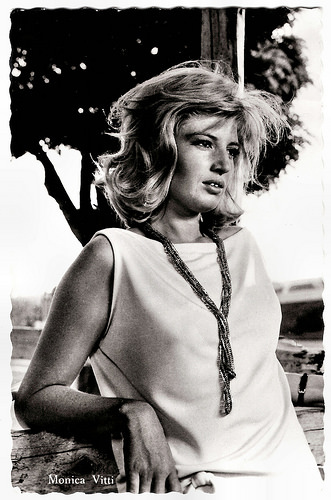
Dutch postcard by De Muinck en Co, Amsterdam, no. 809. Photo: publicity still for L'eclisse/The Eclipse (1962).
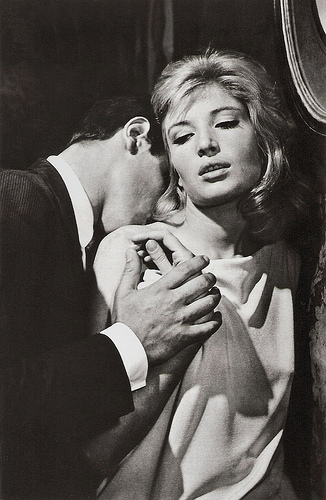
Romanian postcard by Casa Filmului Acin. Photo: publicity still for L'eclisse/The Eclipse (1962).
As long as their love will endure
In EUR, a modernistic suburb of Rome, a young translator, Vittoria ( Monica Vitti ) leaves her lover, the writer Riccardo (Francisco Rabal), and terminates their 4-year relationship. Following several sleepless nights, she visits her estranged mother (Lila Brignone) at the stock exchange.
There the dynamic young stockbroker Piero ( Alain Delon ) casts his romantic gaze in Vittoria's direction. Although they have little in common, Vittoria visits Piero in his office, and they make plans to meet again that night and for every night thereafter - for as long as their love will endure.
Eleanor Mannikka at AllMovie : "There is much to appreciate in this man who is not overly intellectual and is blessedly free of complications, and the same can be said of Vittoria. Yet their innermost fears play upon both of them in ways that go against an honest expression of their love -- and against a lasting relationship."
L'eclisse caps off Michelangelo Antonioni's previous two films, L'avventura (1960) and La Notte (1961), in much the same style. Characteristic for Antonioni's films are the long, significant periods of silence. The people in his film just cannot seem to communicate with each other.

Romanian postcard by Casa Filmulu Acin. C.P.C.S. Photo: publicity still for L'eclisse/The Eclipse (Michelangelo Antonioni, 1962).
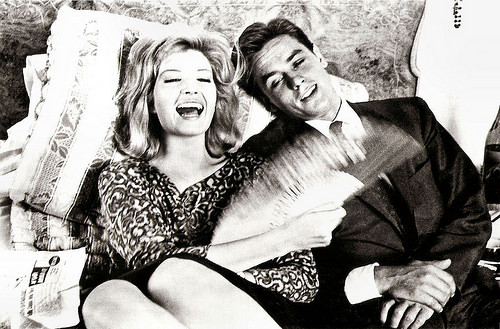
Romanian postcard by Casa Filmului Acin. Photo: publicity still for L'eclisse/The Eclipse (1962).
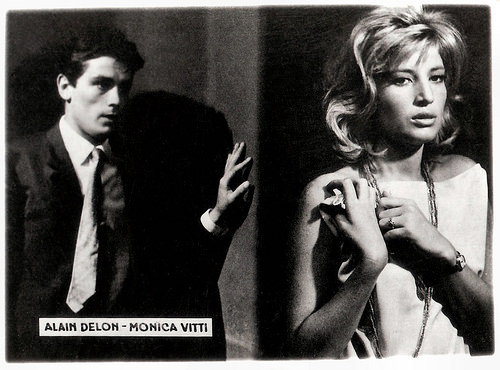
Small Romanian collectors card by Casa Filmului Acin. Photo: publicity still for L'eclisse/The Eclipse (1962).
A form of poetry
L'eclisse rejects action in favour of contemplation. Images and design are more important than character and story. The long takes and elegant compositions, filmed by Gianni De Venanzo, the elongated views on a building or a street-light, manage to create a form of poetry.
With her wild blond hair, Monica Vitti is perfect as the confused Vittoria. She displays just enough emotion to realise the character, but is malleable enough for Antonioni to illustrate his theme through her.
Alain Delon never looked more handsome than in L'Eclisse. He conveys emotions easily with just the flick of an eyebrow. Delon portrays the materialistic, spiritually empty stockbroker quite effectively.
Although it won several awards, L'Eclisse was never a commercial success and many people seem to find the film boring. It is not. Go and watch it closely and let yourself be hypnotised by Antonioni. Jason Ankeny at AllMovie : "Haunted by a sense of instability and impermanence, his work defined a cinema of possibilities; in Antonioni's world, riddles were not answered, but simply evaporated into other riddles."
Eye Film Institute in Amsterdam organises not only the exhibition Michelangelo Antonioni – Il maestro del cinema moderno but also a film retrospective on Antonioni.
Original trailer for L'eclisse/The Eclipse (1962) with the title song by Mina . Source: xx999xx999 (YouTube).
Trailer L'eclisse/The Eclipse (1962). Source: moviolamagics (YouTube).
Sources: Jason Ankeny (AllMovie), Eleanor Mannikka (AllMovie), TCM, Wikipedia and IMDb.

Dutch postcard by De Muinck en Co, Amsterdam, no. 809. Photo: publicity still for L'eclisse/The Eclipse (1962).

Romanian postcard by Casa Filmului Acin. Photo: publicity still for L'eclisse/The Eclipse (1962).
As long as their love will endure
In EUR, a modernistic suburb of Rome, a young translator, Vittoria ( Monica Vitti ) leaves her lover, the writer Riccardo (Francisco Rabal), and terminates their 4-year relationship. Following several sleepless nights, she visits her estranged mother (Lila Brignone) at the stock exchange.
There the dynamic young stockbroker Piero ( Alain Delon ) casts his romantic gaze in Vittoria's direction. Although they have little in common, Vittoria visits Piero in his office, and they make plans to meet again that night and for every night thereafter - for as long as their love will endure.
Eleanor Mannikka at AllMovie : "There is much to appreciate in this man who is not overly intellectual and is blessedly free of complications, and the same can be said of Vittoria. Yet their innermost fears play upon both of them in ways that go against an honest expression of their love -- and against a lasting relationship."
L'eclisse caps off Michelangelo Antonioni's previous two films, L'avventura (1960) and La Notte (1961), in much the same style. Characteristic for Antonioni's films are the long, significant periods of silence. The people in his film just cannot seem to communicate with each other.

Romanian postcard by Casa Filmulu Acin. C.P.C.S. Photo: publicity still for L'eclisse/The Eclipse (Michelangelo Antonioni, 1962).

Romanian postcard by Casa Filmului Acin. Photo: publicity still for L'eclisse/The Eclipse (1962).

Small Romanian collectors card by Casa Filmului Acin. Photo: publicity still for L'eclisse/The Eclipse (1962).
A form of poetry
L'eclisse rejects action in favour of contemplation. Images and design are more important than character and story. The long takes and elegant compositions, filmed by Gianni De Venanzo, the elongated views on a building or a street-light, manage to create a form of poetry.
With her wild blond hair, Monica Vitti is perfect as the confused Vittoria. She displays just enough emotion to realise the character, but is malleable enough for Antonioni to illustrate his theme through her.
Alain Delon never looked more handsome than in L'Eclisse. He conveys emotions easily with just the flick of an eyebrow. Delon portrays the materialistic, spiritually empty stockbroker quite effectively.
Although it won several awards, L'Eclisse was never a commercial success and many people seem to find the film boring. It is not. Go and watch it closely and let yourself be hypnotised by Antonioni. Jason Ankeny at AllMovie : "Haunted by a sense of instability and impermanence, his work defined a cinema of possibilities; in Antonioni's world, riddles were not answered, but simply evaporated into other riddles."
Eye Film Institute in Amsterdam organises not only the exhibition Michelangelo Antonioni – Il maestro del cinema moderno but also a film retrospective on Antonioni.
Original trailer for L'eclisse/The Eclipse (1962) with the title song by Mina . Source: xx999xx999 (YouTube).
Trailer L'eclisse/The Eclipse (1962). Source: moviolamagics (YouTube).
Sources: Jason Ankeny (AllMovie), Eleanor Mannikka (AllMovie), TCM, Wikipedia and IMDb.
Published on September 11, 2015 22:00
September 10, 2015
Nils Poppe
Actor, director and screenwriter Nils Poppe (1908–2000) was often referred to as the Swedish Charlie Chaplin. He is internationally best known for his dramatic part as the jester in Ingmar Bergman's Det sjunde inseglet/The Seventh Sea (1957), but in Sweden he was much loved as a comedian and participated in over 50 films on cinema and TV.
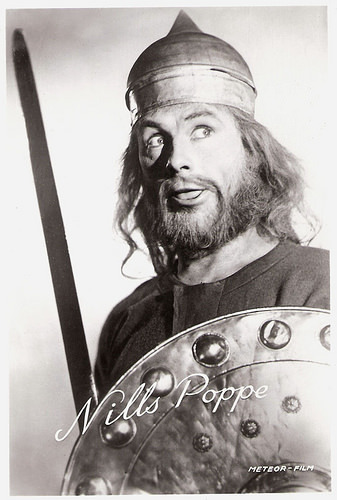
Dutch postcard by Scala Theater, Utrecht, 1949. Photo: Meteor-Film. Publicity still for Ballongen/The Balloon (Göran Gentele, Nils Poppe, 1947). Travelling from one time-frame to another by means of a magic balloon, Poppe is seen in this film as an 8th century Viking, a 13th century Turkish Caliph, a 17th century French King and a present-day (1946) college student.
Smash Hit
Nils Poppe was born as Nils Einar Jönsson in Malmö, Sweden, in 1908. His mother was unmarried and brought him into an orphanage. After two years he was adopted by Anders and Amanda Jönsson in Malmö. At school he became interested in acting and while performing in a school play, he already showed his comedy skills.
In 1930, he started as a serious stage actor at the Hippodromteatern in Malmö. He quickly realized that he was better suited for comedy, revue, operetta and musical, especially as he also was a good dancer and singer. Four years later, he moved to Stockholm to appear in the Klangerevyn (Klang Revue) at the Folkets Hus-teatern (People's House Theatre).
There he first did his Charlie Chaplin parody. Nils Poppe often would be compared to Chaplin. The similarities were numerous, even if Poppe over time developed his very own style.
In 1937 he made his film debut and appeared in Swedish romantic comedies like Skicka hem Nr. 7/Send Home Number 7 (Schamyl Bauman, Gideon Wahlberg, 1937) and Adolf i eld och lågor/Adolf on fire (Per-Axel Branner, 1939). His first leading role was in the comedy Melodin från Gamla Stan/The melody of the Old Town (Ragnar Frisk, 1939).
During the 1940s, he became Sweden's leading film comedian. His comedies included Beredskapspojkar/Prepared boys (Sigurd Wallén, 1941) with Carl Reinholdz, and Blåjackor/Sailors (Rolf Husberg, 1945). He directed himself for the first time in Pengar - en tragikomisk saga/Money - a tragicomic saga (1946). At IMDb , Anders Emil Lundin writes: “This film is a proof of Poppe's genius as an actor. Not only does the story with the seven workers in the forest and little innocent Harry Orvar resemble the fairy tale ‘Snow White’ but it also shows that Poppe could play all varieties of roles - from comedy to tragedy.” It earned Poppe the Swedish equivalent of the Oscar.
In Scandinavia, Poppe is probably best remembered for his character Fabian Bom, which he introduced in Soldat Bom/Soldier Bom (Lars-Eric Kjellgren, 1948) with Gunnar Björnstrand. Bom is the very meticulous stationmaster, who makes sure that the train leaves exactly on the second. But his beloved Plum-Plum, the major's daughter, is infatuated with army officers. To regain her attention, he joins the army. Bom becomes a soldier who loves the military training, long marches as well as hard labour as punishment. He meets Agnes, who falls madly in love with him. The film became a smash hit and ran for 48 weeks in Stockholm cinemas It was the start of a series of 7 films around Bom, including Papa Bom/Father Bom (Lars-Eric Kjellgren, 1949) and Tull-Bom/Customs Officer Bom (Lars-Eric Kjellgren, 1951), with Inga Landgré, who had become his wife in 1949.
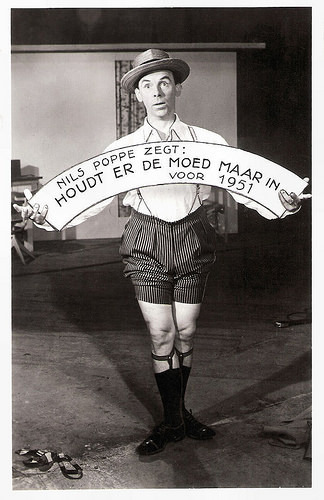
Dutch postcard by Scala Theater, Utrecht, 1950. Photo: publicity for Tappa inte sugen/Don't give up (Lars-Eric Kjellgren, 1947).
A skillful blend of realistic drama
During the 1950s, Nils Poppe continued to star in Swedish comedies. The Bom films were international successes and especially popular in Germany. Another popular returning character was Sten Stensson, an academic upholding a high moral standard. He figured in Ballongen/The balloon (Göran Gentele, Nils Poppe, 1947) and Ljuset från Lund/The light from Lund (Hans Lagerkvist, 1955).
It surprised many when renowned film director Ingmar Bergman decided to cast him as the street performer Jof in his drama Det sjunde inseglet/The Seventh Seal (1957) opposite Max von Sydow and Gunnar Björnstrand. Tom Wiener at AllMovie : “The Seventh Seal is a skillful blend of realistic drama (the disillusioned knight returning from the Crusades in a land wracked by plague and madness) and the allegorical (most famously, the chess game and further encounters with a black-robed figure representing Death). The historical setting provides a convenient vehicle for Bergman to deal with issues of death and spirituality that are ultimately timeless.”
Poppe showed with his role that he could also convey much warmth and compassion. He would later participate in another Bergman film, Djävulens öga/The Devil's Eye (Ingmar Bergman, 1960), starring Jarl Kulle and Bibi Andersson.
After a period of inactivity in the early 1960s, Poppe started to work for television. In 1966, he took over the running of Fredriksdal´s Open-air Theatre in Helsingborg, where he produced a comedy for each summer. Through a deal with Swedish Television, he managed to make the theatre known throughout the country and also revitalized his own career. People flocked from all over Sweden to see Poppe in farces like Charley’s Aunt. He also played in productions of other theatres. Particularly memorable is his Tevye in the musical Fiddler on the Roof at the Helsingborg City Theatre in 1979.
He retired from the stage at the age of 85, still able to dance, but a few years later he suffered from several strokes, which left him both blind, speechless and immobile. In 2000, he finally died in Helsingborg, Sweden, at the age of 92. Nils Poppe was married twice; first to actress Inga Landgré (1949–1959), and then to actress Gunilla Poppe (née Sundberg) (1965–2000) who was 29 years younger than him. He had two children with each wife. They are actress Anja Landgré, Dan Landgré, dancer/actress Mia Poppe and troubadour/actor Thomas Poppe.
Scene from Soldat Bom/Soldier Bom (1948). Source: SandraF1990 (YouTube).
Official Trailer Det sjunde inseglet/The Seventh Seal (1958). Source: The Cultbox (YouTube).
This is a post for Postcard Friendship Friday, hosted by Beth at the blog The Best Hearts are Crunchy. You can visit her by clicking on the button below.

Sources: Tom Wiener (AllMovie), Hal Erickson (AllMovie), Anders Emil Lundin (IMDb), Peter Robsahm (Find A Grave), Wikipedia (Swedish and English) and .

Dutch postcard by Scala Theater, Utrecht, 1949. Photo: Meteor-Film. Publicity still for Ballongen/The Balloon (Göran Gentele, Nils Poppe, 1947). Travelling from one time-frame to another by means of a magic balloon, Poppe is seen in this film as an 8th century Viking, a 13th century Turkish Caliph, a 17th century French King and a present-day (1946) college student.
Smash Hit
Nils Poppe was born as Nils Einar Jönsson in Malmö, Sweden, in 1908. His mother was unmarried and brought him into an orphanage. After two years he was adopted by Anders and Amanda Jönsson in Malmö. At school he became interested in acting and while performing in a school play, he already showed his comedy skills.
In 1930, he started as a serious stage actor at the Hippodromteatern in Malmö. He quickly realized that he was better suited for comedy, revue, operetta and musical, especially as he also was a good dancer and singer. Four years later, he moved to Stockholm to appear in the Klangerevyn (Klang Revue) at the Folkets Hus-teatern (People's House Theatre).
There he first did his Charlie Chaplin parody. Nils Poppe often would be compared to Chaplin. The similarities were numerous, even if Poppe over time developed his very own style.
In 1937 he made his film debut and appeared in Swedish romantic comedies like Skicka hem Nr. 7/Send Home Number 7 (Schamyl Bauman, Gideon Wahlberg, 1937) and Adolf i eld och lågor/Adolf on fire (Per-Axel Branner, 1939). His first leading role was in the comedy Melodin från Gamla Stan/The melody of the Old Town (Ragnar Frisk, 1939).
During the 1940s, he became Sweden's leading film comedian. His comedies included Beredskapspojkar/Prepared boys (Sigurd Wallén, 1941) with Carl Reinholdz, and Blåjackor/Sailors (Rolf Husberg, 1945). He directed himself for the first time in Pengar - en tragikomisk saga/Money - a tragicomic saga (1946). At IMDb , Anders Emil Lundin writes: “This film is a proof of Poppe's genius as an actor. Not only does the story with the seven workers in the forest and little innocent Harry Orvar resemble the fairy tale ‘Snow White’ but it also shows that Poppe could play all varieties of roles - from comedy to tragedy.” It earned Poppe the Swedish equivalent of the Oscar.
In Scandinavia, Poppe is probably best remembered for his character Fabian Bom, which he introduced in Soldat Bom/Soldier Bom (Lars-Eric Kjellgren, 1948) with Gunnar Björnstrand. Bom is the very meticulous stationmaster, who makes sure that the train leaves exactly on the second. But his beloved Plum-Plum, the major's daughter, is infatuated with army officers. To regain her attention, he joins the army. Bom becomes a soldier who loves the military training, long marches as well as hard labour as punishment. He meets Agnes, who falls madly in love with him. The film became a smash hit and ran for 48 weeks in Stockholm cinemas It was the start of a series of 7 films around Bom, including Papa Bom/Father Bom (Lars-Eric Kjellgren, 1949) and Tull-Bom/Customs Officer Bom (Lars-Eric Kjellgren, 1951), with Inga Landgré, who had become his wife in 1949.

Dutch postcard by Scala Theater, Utrecht, 1950. Photo: publicity for Tappa inte sugen/Don't give up (Lars-Eric Kjellgren, 1947).
A skillful blend of realistic drama
During the 1950s, Nils Poppe continued to star in Swedish comedies. The Bom films were international successes and especially popular in Germany. Another popular returning character was Sten Stensson, an academic upholding a high moral standard. He figured in Ballongen/The balloon (Göran Gentele, Nils Poppe, 1947) and Ljuset från Lund/The light from Lund (Hans Lagerkvist, 1955).
It surprised many when renowned film director Ingmar Bergman decided to cast him as the street performer Jof in his drama Det sjunde inseglet/The Seventh Seal (1957) opposite Max von Sydow and Gunnar Björnstrand. Tom Wiener at AllMovie : “The Seventh Seal is a skillful blend of realistic drama (the disillusioned knight returning from the Crusades in a land wracked by plague and madness) and the allegorical (most famously, the chess game and further encounters with a black-robed figure representing Death). The historical setting provides a convenient vehicle for Bergman to deal with issues of death and spirituality that are ultimately timeless.”
Poppe showed with his role that he could also convey much warmth and compassion. He would later participate in another Bergman film, Djävulens öga/The Devil's Eye (Ingmar Bergman, 1960), starring Jarl Kulle and Bibi Andersson.
After a period of inactivity in the early 1960s, Poppe started to work for television. In 1966, he took over the running of Fredriksdal´s Open-air Theatre in Helsingborg, where he produced a comedy for each summer. Through a deal with Swedish Television, he managed to make the theatre known throughout the country and also revitalized his own career. People flocked from all over Sweden to see Poppe in farces like Charley’s Aunt. He also played in productions of other theatres. Particularly memorable is his Tevye in the musical Fiddler on the Roof at the Helsingborg City Theatre in 1979.
He retired from the stage at the age of 85, still able to dance, but a few years later he suffered from several strokes, which left him both blind, speechless and immobile. In 2000, he finally died in Helsingborg, Sweden, at the age of 92. Nils Poppe was married twice; first to actress Inga Landgré (1949–1959), and then to actress Gunilla Poppe (née Sundberg) (1965–2000) who was 29 years younger than him. He had two children with each wife. They are actress Anja Landgré, Dan Landgré, dancer/actress Mia Poppe and troubadour/actor Thomas Poppe.
Scene from Soldat Bom/Soldier Bom (1948). Source: SandraF1990 (YouTube).
Official Trailer Det sjunde inseglet/The Seventh Seal (1958). Source: The Cultbox (YouTube).
This is a post for Postcard Friendship Friday, hosted by Beth at the blog The Best Hearts are Crunchy. You can visit her by clicking on the button below.

Sources: Tom Wiener (AllMovie), Hal Erickson (AllMovie), Anders Emil Lundin (IMDb), Peter Robsahm (Find A Grave), Wikipedia (Swedish and English) and .
Published on September 10, 2015 22:00
September 9, 2015
Walter Chiari
Good looking Walter Chiari (1924-1991) was a hugely successful Italian stage and screen actor. He appeared opposite Anna Magnani in Luchino Visconti's Bellissima (1951) and played countless roles in the Commedia all'italiana. Chiari achieved international success with The Little Hut (1957), Bonjour Tristesse (1958), Chimes at Midnight (1966), and The Valachi Papers (1972). In the late 1950s and 1960s he was one of the main protagonists of the ‘Dolce Vita’, the glitzy and glamorous Italian jet-set scene, but a drugs scandal in 1970 hurt his screen career.
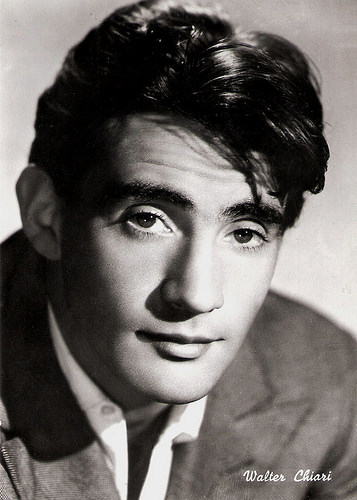
Italian postcard by Bromofoto, Milano, no. 311.
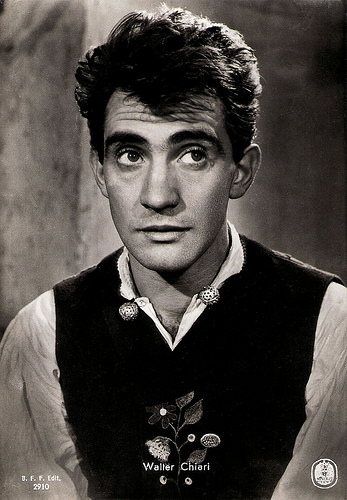
Italian postcard by B.F.F. Edit., Firenze, no. 2910. Photo: Minerva Film.
Bellissima
Walter Chiari was the stage name of Walter Annicchiarico, born in Verona, Italy in 1924. His father, Carmelo Annichiarico, was a police official and his mother Enza was an elementary school teacher. The young Chiari was very athletic and both became a swimming and boxing champion. He joined the army of the Italian Social Republic of Salò. After the end of the war, he spent a few months in prison for collaborating with the fascist regime.
He got his first stage job thanks to actress Marisa Maresca, who offered him a part in the show Se ti bacia Lola (If you kiss Lola). Besides for his good looks, he was spotted for his improvisation talent. Chiari started his film career with a role in the drama Vanità/Vanity (Giorgio Pastina, 1947) with Liliana Laine and Dina Galli . The film, set in nineteenth century Milan, is based on a play by Carlo Bertolazzi. Chiari was awarded a Nastro d'Argento for best debut performance.
Next he co-starred in the comedy hit Totò al giro d'Italia /Totò at the Tour of Italy (Mario Mattoli, 1948) starring Totò . It was the first of a long series of comedies, all directed by Mario Mattoli. Very successful was also I cadetti di Guascogna/The Cadets of Gascony (Mario Mattioli, 1950), in which he acted with another newcomer, Ugo Tognazzi . He made comedies with other directors too, such as O.K. Nerone/O.K. Nero (Mario Soldati, 1951) with Gino Cervi as emperor Nero.
Chiari appeared as a young, handsome scoundrel opposite Anna Magnani in Luchino Visconti's neorealism drama Bellissima (1951). The film, which is a satire of the film industry, was shot at the Cinecittà studios. Alessandro Blasetti, a contemporary film director, appears as himself. Bellissima centers on a working-class mother in Rome, Maddalena ( Anna Magnani ), who drags her young daughter (Tina Apicella) to Cinecittà for the ‘Prettiest Girl in Rome’ contest. Maddalena is a stage mother who loves movies and whose efforts to promote her daughter grow increasingly frenzied.
His first foreign film was the French-Italian film La minute de vérité/The Moment of Truth (Jean Dellannoy, 1952) with Michèle Morgan and Jean Gabin . It was followed by Nana/Nanà (Christian-Jaque, 1955), an adaptation of Émile Zola's novel Nana, starring Martine Carol and Charles Boyer , and the crime film Je suis un sentimental/Headlines of Destruction (John Berry, 1955) with Eddie Constantine . In Italy, he co-starred in the comedy Donatella (Mario Monicelli, 1956) for which Elsa Martinelli won the Silver Bear for Best Actress at the 6th Berlin International Film Festival.
For MGM, he co-starred in the romantic comedy The Little Hut (Mark Robson, 1957). During the making of The Little Hut, he met Ava Gardner who was still formally married to Frank Sinatra but lived already estranged from him. They started a passionate and tumultuous relationship. Next he featured for Columbia in Bonjour Tristesse/Hello, Sadness (Otto Preminger, 1958) based on the novel by Françoise Sagan. In the meantime he figured permanently in the tabloids as a womanizer. He had affairs with Silvana Pampanini , Elsa Martinelli , Delia Scala, Lucia Bose (with whom he had a long engagement), Anita Ekberg , Princess Maria Gabriella of Savoy and Italian singer Mina .
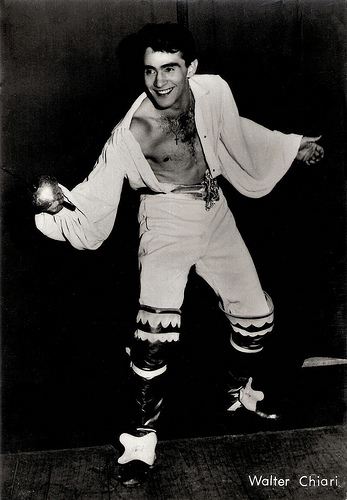
Italian postcard by Bromofoto, Milano, no. 136.
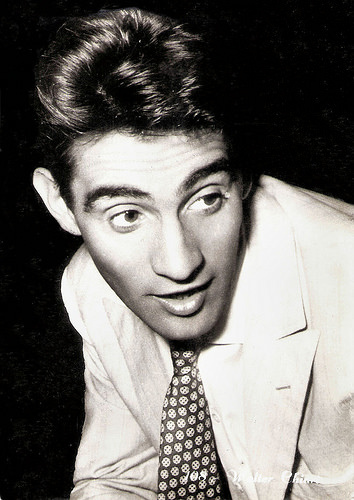
Italian postcard by Turismofoto, no. 108.
Don't worry, I'm merely catching up with sleep
During the 1960s, Walter Chiari continued to stare in light comedies by such Italian directors as Steno, Mario Monicelli, Dino Risi and Nanni Loy.
Unlike many Italian actors of the time he had a full and fluent command of English that he put to good use in his Broadway spell, which in 1961 saw him performing in The Gay Life (a musical comedy inspired by an Arthur Schnitzler play) for 113 shows. He starred in They're a Weird Mob (Michael Powell, 1966), the last of the Powell and Pressburger films, based on a popular Australian novel by John O'Grady. He also appeared in Orson Welles ’ Chimes at Midnight (1966), the Pan-European action-comedy Monte Carlo or Bust! (Ken Annakin, Sam Itzkovitch, 1969), the Australian film Squeeze a Flower (Marc Daniels, 1970), and the crime film The Valachi Papers (Terence Young, 1972) with Charles Bronson and Lino Ventura . The Valachi Papers tells the true story of Joseph Valachi, a Mafia informant in the early 1960s.
In 1970 Chiari was arrested and jailed in Rome on suspicion of cocaine possession and trafficking, with 70 days passing before he was bailed. Despite being known in show business as a cocaine user, Chiari enjoyed for years the de facto impunity often accorded to members of his trade (provided he kept his addiction private). The willingness of authorities to prosecute him, mounting a nationwide scandal, was seen by some as an attempt to distract public opinion from the fruitless search for the culprits of the Piazza Fontana bombing, which precipitated Italy in fear.
After his release and partial acquittal (he was deemed not guilty of the trafficking count and received a lenient sentence for the charge of drug possession for personal use) his career never completely recovered. According to Wikipedia, the Italian state television was off-limits for him, and all he could aspire to were parts in low-key comedies and local television appearances.
He concentrated on theatre and gave some good performances in plays such as Richard Brinsley Sheridan's The Critic, Marc Perrier's Six heures au plus tard and Samuel Beckett's Endgame. His final film was the Italian romance-drama Tracce di vita amorosa/Traces of an Amorous Life (Peter Del Monte, 1990) with Valeria Golina, which was in the competition at the 47th Venice International Film Festival.
The following year, Chiari died of a sudden heart attack in Milan, at home, in 1991. On that same day he had undertaken a complete, positive medical check-up. Not showing up at a dinner with a theatre manager where he should have discussed his involvement in a new production he was found by his host who reached the residence where he was living at the time, sitting in an armchair, in front of a functioning television. His gravestone carries the line he once mentioned to director Dino Risi as his favourite choice for an epitaph: "Don't worry, I'm merely catching up with sleep".
In 1969 Walter Chiari had married actress Alida Chelli. They would divorce in 1981 and had one child. His son, Simone Annicchiarico (1970) became the lead singer of an Italian rock band and hosted the TV programs La Valigia Dei Sogni/Suitcase Of Dreams (2008-2009) and Italia's Got Talent (2009).
Italian trailer for Bellissima (Luchino Visconti, 1951). Source: CinemAmbiente (YouTube).
Italian trailer for Il giovedi (Dino Risi, 1963). Source: primocarnera07 (YouTube).
Trailer for They're a Weird Mob (Michael Powell, 1966). Source: irena0100 (YouTube).
Trailer for The Valachi Papers (Terence Young, 1972). Source: Tony Baretta (YouTube).
Sources: Hal Erickson (AllMovie), Biografieonline (Italian), Wikipedia (Italian and English) and .

Italian postcard by Bromofoto, Milano, no. 311.

Italian postcard by B.F.F. Edit., Firenze, no. 2910. Photo: Minerva Film.
Bellissima
Walter Chiari was the stage name of Walter Annicchiarico, born in Verona, Italy in 1924. His father, Carmelo Annichiarico, was a police official and his mother Enza was an elementary school teacher. The young Chiari was very athletic and both became a swimming and boxing champion. He joined the army of the Italian Social Republic of Salò. After the end of the war, he spent a few months in prison for collaborating with the fascist regime.
He got his first stage job thanks to actress Marisa Maresca, who offered him a part in the show Se ti bacia Lola (If you kiss Lola). Besides for his good looks, he was spotted for his improvisation talent. Chiari started his film career with a role in the drama Vanità/Vanity (Giorgio Pastina, 1947) with Liliana Laine and Dina Galli . The film, set in nineteenth century Milan, is based on a play by Carlo Bertolazzi. Chiari was awarded a Nastro d'Argento for best debut performance.
Next he co-starred in the comedy hit Totò al giro d'Italia /Totò at the Tour of Italy (Mario Mattoli, 1948) starring Totò . It was the first of a long series of comedies, all directed by Mario Mattoli. Very successful was also I cadetti di Guascogna/The Cadets of Gascony (Mario Mattioli, 1950), in which he acted with another newcomer, Ugo Tognazzi . He made comedies with other directors too, such as O.K. Nerone/O.K. Nero (Mario Soldati, 1951) with Gino Cervi as emperor Nero.
Chiari appeared as a young, handsome scoundrel opposite Anna Magnani in Luchino Visconti's neorealism drama Bellissima (1951). The film, which is a satire of the film industry, was shot at the Cinecittà studios. Alessandro Blasetti, a contemporary film director, appears as himself. Bellissima centers on a working-class mother in Rome, Maddalena ( Anna Magnani ), who drags her young daughter (Tina Apicella) to Cinecittà for the ‘Prettiest Girl in Rome’ contest. Maddalena is a stage mother who loves movies and whose efforts to promote her daughter grow increasingly frenzied.
His first foreign film was the French-Italian film La minute de vérité/The Moment of Truth (Jean Dellannoy, 1952) with Michèle Morgan and Jean Gabin . It was followed by Nana/Nanà (Christian-Jaque, 1955), an adaptation of Émile Zola's novel Nana, starring Martine Carol and Charles Boyer , and the crime film Je suis un sentimental/Headlines of Destruction (John Berry, 1955) with Eddie Constantine . In Italy, he co-starred in the comedy Donatella (Mario Monicelli, 1956) for which Elsa Martinelli won the Silver Bear for Best Actress at the 6th Berlin International Film Festival.
For MGM, he co-starred in the romantic comedy The Little Hut (Mark Robson, 1957). During the making of The Little Hut, he met Ava Gardner who was still formally married to Frank Sinatra but lived already estranged from him. They started a passionate and tumultuous relationship. Next he featured for Columbia in Bonjour Tristesse/Hello, Sadness (Otto Preminger, 1958) based on the novel by Françoise Sagan. In the meantime he figured permanently in the tabloids as a womanizer. He had affairs with Silvana Pampanini , Elsa Martinelli , Delia Scala, Lucia Bose (with whom he had a long engagement), Anita Ekberg , Princess Maria Gabriella of Savoy and Italian singer Mina .

Italian postcard by Bromofoto, Milano, no. 136.

Italian postcard by Turismofoto, no. 108.
Don't worry, I'm merely catching up with sleep
During the 1960s, Walter Chiari continued to stare in light comedies by such Italian directors as Steno, Mario Monicelli, Dino Risi and Nanni Loy.
Unlike many Italian actors of the time he had a full and fluent command of English that he put to good use in his Broadway spell, which in 1961 saw him performing in The Gay Life (a musical comedy inspired by an Arthur Schnitzler play) for 113 shows. He starred in They're a Weird Mob (Michael Powell, 1966), the last of the Powell and Pressburger films, based on a popular Australian novel by John O'Grady. He also appeared in Orson Welles ’ Chimes at Midnight (1966), the Pan-European action-comedy Monte Carlo or Bust! (Ken Annakin, Sam Itzkovitch, 1969), the Australian film Squeeze a Flower (Marc Daniels, 1970), and the crime film The Valachi Papers (Terence Young, 1972) with Charles Bronson and Lino Ventura . The Valachi Papers tells the true story of Joseph Valachi, a Mafia informant in the early 1960s.
In 1970 Chiari was arrested and jailed in Rome on suspicion of cocaine possession and trafficking, with 70 days passing before he was bailed. Despite being known in show business as a cocaine user, Chiari enjoyed for years the de facto impunity often accorded to members of his trade (provided he kept his addiction private). The willingness of authorities to prosecute him, mounting a nationwide scandal, was seen by some as an attempt to distract public opinion from the fruitless search for the culprits of the Piazza Fontana bombing, which precipitated Italy in fear.
After his release and partial acquittal (he was deemed not guilty of the trafficking count and received a lenient sentence for the charge of drug possession for personal use) his career never completely recovered. According to Wikipedia, the Italian state television was off-limits for him, and all he could aspire to were parts in low-key comedies and local television appearances.
He concentrated on theatre and gave some good performances in plays such as Richard Brinsley Sheridan's The Critic, Marc Perrier's Six heures au plus tard and Samuel Beckett's Endgame. His final film was the Italian romance-drama Tracce di vita amorosa/Traces of an Amorous Life (Peter Del Monte, 1990) with Valeria Golina, which was in the competition at the 47th Venice International Film Festival.
The following year, Chiari died of a sudden heart attack in Milan, at home, in 1991. On that same day he had undertaken a complete, positive medical check-up. Not showing up at a dinner with a theatre manager where he should have discussed his involvement in a new production he was found by his host who reached the residence where he was living at the time, sitting in an armchair, in front of a functioning television. His gravestone carries the line he once mentioned to director Dino Risi as his favourite choice for an epitaph: "Don't worry, I'm merely catching up with sleep".
In 1969 Walter Chiari had married actress Alida Chelli. They would divorce in 1981 and had one child. His son, Simone Annicchiarico (1970) became the lead singer of an Italian rock band and hosted the TV programs La Valigia Dei Sogni/Suitcase Of Dreams (2008-2009) and Italia's Got Talent (2009).
Italian trailer for Bellissima (Luchino Visconti, 1951). Source: CinemAmbiente (YouTube).
Italian trailer for Il giovedi (Dino Risi, 1963). Source: primocarnera07 (YouTube).
Trailer for They're a Weird Mob (Michael Powell, 1966). Source: irena0100 (YouTube).
Trailer for The Valachi Papers (Terence Young, 1972). Source: Tony Baretta (YouTube).
Sources: Hal Erickson (AllMovie), Biografieonline (Italian), Wikipedia (Italian and English) and .
Published on September 09, 2015 22:00
September 8, 2015
Imported from the USA: Steve Reeves
Handsome, musclebound Steve Reeves (1926-2000) was an American bodybuilder and actor, who was a huge success in Hercules (1958) and other Peplum films, the Italian sword-and-sandal epics. At the peak of his career, around 1960, he was reputedly the highest-paid actor in Europe.
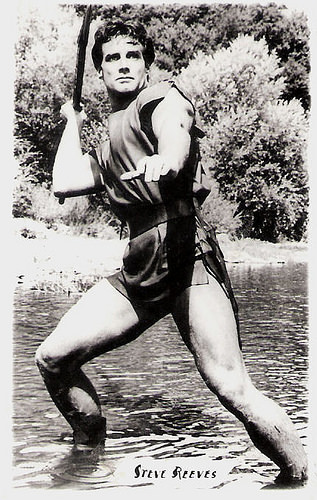
Small Romanian collectors card.
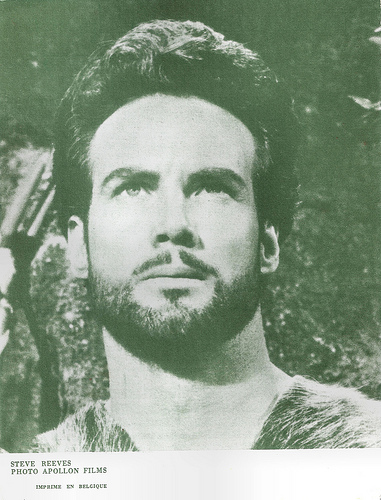
Belgian collectors card. Photo: Apollon Films.
Mr. Universe
Stephen L. Reeves was born on a cattle ranch in the small town of Glasgow, Montana, in 1926. At the age of six months, he won his first fitness title as Healthiest Baby of Valley County. When Steve was 10, his father, Lester Dell Reeves, died in a farming accident. With his mother Goldie Reeves, Steve moved to California.
In high school in Oakland, Reeves began to work out regularly with weights, and he eventually came to the attention of Ed Yarick, who ran a bodybuilding gym. After graduating from high school, he enlisted in the Army, and served in the Philippines during World War II and in Japan afterwards.
After his military service, at the age of 20, he won the title Mr. Pacific Coast (1946) in Oregon, which led to his titles of Mr. Western America (1947), Mr. America (1947), Mr. World (1948) and, ultimately, Mr. Universe (1950). The very night after he won the Mr. Universe title, he announced his retirement from bodybuilding competition at the age of 25.
With all the body-worshipping publicity he garnered, Reeves had become interested in pursuing an acting career. He moved to New York and studied acting under Stella Adler but after arguments was refunded his tuition. He was selected by Cecil B. DeMille for the lead role of Samson in the biblical costumer Samson and Delilah (1949), after Burt Lancaster proved unavailable. In order to look convincing on-camera, he was told to lose 15 pounds as the camera added weight. He would not be able to compete in bodybuilding with the diminished weight, so he turned the movie offer down. The part instead went to Victor Mature.
In 1949 Steve did film a Tarzan-type television pilot called Kimbar of the Jungle. He was one of the Olympic Team members not interested in the charms of Jane Russell in Gentlemen Prefer Blondes (Howard Hawks, 1953). In 1954 he had a small role in the musical Athena (Richard Thorpe, 1954) playing Jane Powell's boyfriend. The same year Reeves had a small role as a detective in Ed Wood’s attempt to make a serious Film-Noir, Jail Bait (Edward D. Wood Jr., 1954). On TV, Reeves guest starred on The Ray Bolger Show (1954) and The George Burns and Gracie Allen Show (1957). These roles were mostly posing bits or walk-ons. To Hollywood, Reeves was just a body. But then his fortunes turned.
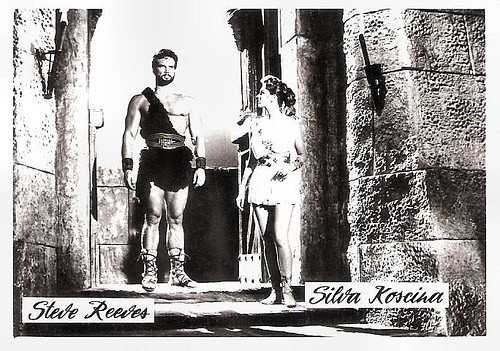
Small Romanian collectors card. Photo: publicity still for Ercole e la regina di Lidia/Hercules Unchained (Pietro Francisci, 1959) with Sylva Koscina .
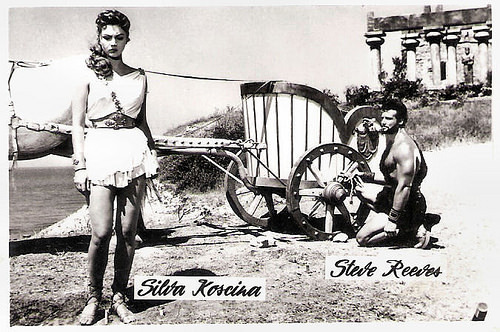
Small Romanian collectors card. Photo: publicity still for Ercole e la regina di Lidia/Hercules Unchained (Pietro Francisci, 1959) with Sylva Koscina .
Herculean acting talent by any stretch
Italian film director Pietro Francisci’s daughter saw Steve Reeves in Athena (1954) and she recommended him to her father. Francisci invited Reeves to come to Cinecitta, the Roman film studios. In 1957, Reeves played the lead character in Le fatiche di Ercole/Hercules (Pietro Francisci, 1958), opposite gorgeous Sylva Koscina .
Hercules was a relatively low-budget epic based loosely on the tales of Jason and the Argonauts, though inserting Hercules into the lead role. Gary Brumburgh at IMDb : “Though he did not possess a Herculean acting talent by any stretch, handsome bodybuilder Steve Reeves certainly had an enviable Herculean physique, and made plenty good use of it in Europe.”
Independent film producer Joseph E. Levine took a big chance and bought the rights to the film's American release. He added a soundtrack dubbed in English and after a major US advertising campaign on television and in the newspapers, Hercules became one of the surprise hits of 1959.
Reeves was ‘overnight’ a star. The film’s international success quickly led to the sequel Ercole e la regina di Lidia/Hercules Unchained (Pietro Francisci, 1959), again with Sylva Koscina . Hercules Unchained made even more money and became one of the year's biggest grossing films.
Although he is now best known for his portrayal of Hercules, Reeves played the character only twice. Next he played 19th century Tatar hero Hadji Murad in Agi Murad il diavolo bianco/White Warrior (Riccardo Freda, 1959) with Giorgia Moll . This was followed by his role as Goliath (in Italy Emiliano) in Il terrore dei barbari/Goliath and the Barbarians (Carlo Campogalliani, 1959) with Chelo Alonso . While filming Gli ultimi giorni di Pompei/The Last Days of Pompeii (Mario Bonnard, Sergio Leone (uncredited), 1959), the chariot Reeves was driving struck a tree and he dislocated his shoulder. This put an end to his more intense exercise routines and caused problems in the following years.
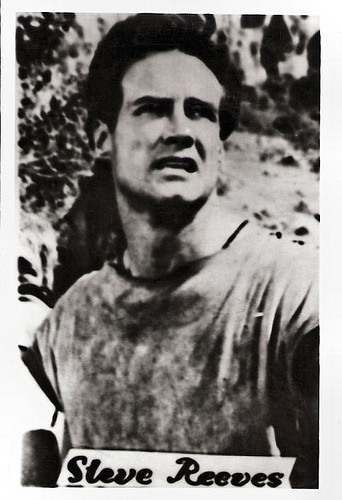
Small Romanian collectors card.
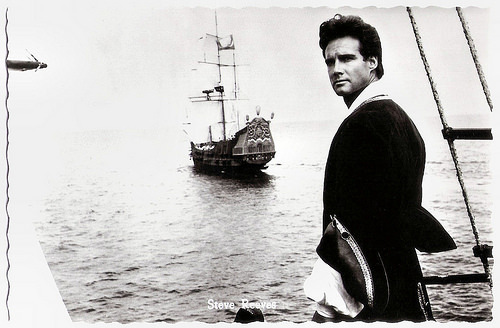
Dutch postcard by N.V. v.h. Weenenk & Snel, Baarn, no. 661. Photo: MGM. Publicity still for Morgan il pirata/Morgan the Pirate (André De Toth, Primo Zeglio, 1960).
Number-one, box-office draw in twenty-five countries
By 1960, Steve Reeves was ranked as the number-one, box-office draw in twenty-five countries around the world. From then on through 1964, Reeves went on to appear in a string of Peplum (sword & sandal films) shot on relatively small budgets.
He played a number of characters on-screen, including Welsh pirate and self-proclaimed governor of Jamaica, Captain Henry Morgan in Morgan il pirata/Morgan the Pirate (André De Toth, Primo Zeglio, 1960), Karim, the fabled Thief of Baghdad in Il ladro di Bagdad/The Thief of Baghdad (Arthur Lubin, Bruno Vailati, 1961), and Randus, the son of Spartacus in Il figlio di Spartacus/The Slave: The Son of Spartacus (Sergio Corbucci, 1962).
He also played Romulus, the legendary founder of Rome in Romolo e Remo/Duel of the Titans (Sergio Corbucci, 1961) opposite Gordon Scott as his twin brother Remus. Reeves reportedly turned down two roles that became international sensations. Cubby Broccoli offered him the role of James Bond in Dr. No (1962), but Reeves refused it because of the low salary the producer offered. Reeves also turned down the role of ‘The Man with No name’ that finally went to Clint Eastwood in A Fistful of Dollars (Sergio Leone, 1964) because he could not believe that "Italians could make a western".
He played Aeneas of Troy in La leggenda di Enea/The Avenger (Giorgio Venturini, 1962) and twice he played Emilio Salgari's Malaysian hero, Sandokan in Sandokan, la tigre di Mompracem/Sandokan the Great (Umberto Lenzi, 1963) with Geneviève Grad , and in I pirati della Malesia/The Pirates of Malaysia (Umberto Lenzi, 1964) with Jacqueline Sassard as the romantic interest. R
eeves’ injury of The Last Days of Pompeii, was aggravated by his stunt work in each successive film, ultimately leading to his retirement from film making. In 1968 he appeared in his final film, Vivo per la tua morte/I Live For Your Death!/A Long Ride From Hell (Camillo Bazzoni,1968), a Spaghetti Western he co-wrote.
His first wife had been Sandra Smith (1955-1956). In 1963, he married Aline Czarzawicz and the couple moved in 1969 to Valley Center, California, northeast of San Diego. He had bought a ranch there with savings from his film career. The next two decades Reeves bred horses and promoted drug-free bodybuilding. He stayed with Aline, until her death in 1989.
In 1994, Reeves and business partner George Helmer started the Steve Reeves International Society, which became through its Internet site, a leading proponent of drug-free bodybuilding. In 1996, it incorporated to become Steve Reeves International Inc. Reeves also wrote the book Powerwalking, and two self-published books, Building the Classic Physique - The Natural Way, and Dynamic Muscle Building.
His last screen appearance was in 2000 when he appeared as himself in the made-for-television A&E Biography: Arnold Schwarzenegger — Flex Appeal. In 2000, Reeves died in a hospital in Escondido, California, from a blood clot after having surgery two days earlier. He passed away on the very day that Ridley Scott's Gladiator (2000) premiered, the first sword-and-sandal epic to be produced by Hollywood in many years. Steve Reeves was 74.
Scene from The George Burns and Gracie Allen Show (1957). Source: Marek546 (YouTube).
American trailer for Le fatiche di Ercole/Hercules (1958). Source: George Helmer (YouTube).
American trailer for Morgan il pirata/Morgan the Pirate (1960). Source: Captain Bijou (YouTube).
Sources: (IMDb), Rick Lyman (The New York Times), Wikipedia and .

Small Romanian collectors card.

Belgian collectors card. Photo: Apollon Films.
Mr. Universe
Stephen L. Reeves was born on a cattle ranch in the small town of Glasgow, Montana, in 1926. At the age of six months, he won his first fitness title as Healthiest Baby of Valley County. When Steve was 10, his father, Lester Dell Reeves, died in a farming accident. With his mother Goldie Reeves, Steve moved to California.
In high school in Oakland, Reeves began to work out regularly with weights, and he eventually came to the attention of Ed Yarick, who ran a bodybuilding gym. After graduating from high school, he enlisted in the Army, and served in the Philippines during World War II and in Japan afterwards.
After his military service, at the age of 20, he won the title Mr. Pacific Coast (1946) in Oregon, which led to his titles of Mr. Western America (1947), Mr. America (1947), Mr. World (1948) and, ultimately, Mr. Universe (1950). The very night after he won the Mr. Universe title, he announced his retirement from bodybuilding competition at the age of 25.
With all the body-worshipping publicity he garnered, Reeves had become interested in pursuing an acting career. He moved to New York and studied acting under Stella Adler but after arguments was refunded his tuition. He was selected by Cecil B. DeMille for the lead role of Samson in the biblical costumer Samson and Delilah (1949), after Burt Lancaster proved unavailable. In order to look convincing on-camera, he was told to lose 15 pounds as the camera added weight. He would not be able to compete in bodybuilding with the diminished weight, so he turned the movie offer down. The part instead went to Victor Mature.
In 1949 Steve did film a Tarzan-type television pilot called Kimbar of the Jungle. He was one of the Olympic Team members not interested in the charms of Jane Russell in Gentlemen Prefer Blondes (Howard Hawks, 1953). In 1954 he had a small role in the musical Athena (Richard Thorpe, 1954) playing Jane Powell's boyfriend. The same year Reeves had a small role as a detective in Ed Wood’s attempt to make a serious Film-Noir, Jail Bait (Edward D. Wood Jr., 1954). On TV, Reeves guest starred on The Ray Bolger Show (1954) and The George Burns and Gracie Allen Show (1957). These roles were mostly posing bits or walk-ons. To Hollywood, Reeves was just a body. But then his fortunes turned.

Small Romanian collectors card. Photo: publicity still for Ercole e la regina di Lidia/Hercules Unchained (Pietro Francisci, 1959) with Sylva Koscina .

Small Romanian collectors card. Photo: publicity still for Ercole e la regina di Lidia/Hercules Unchained (Pietro Francisci, 1959) with Sylva Koscina .
Herculean acting talent by any stretch
Italian film director Pietro Francisci’s daughter saw Steve Reeves in Athena (1954) and she recommended him to her father. Francisci invited Reeves to come to Cinecitta, the Roman film studios. In 1957, Reeves played the lead character in Le fatiche di Ercole/Hercules (Pietro Francisci, 1958), opposite gorgeous Sylva Koscina .
Hercules was a relatively low-budget epic based loosely on the tales of Jason and the Argonauts, though inserting Hercules into the lead role. Gary Brumburgh at IMDb : “Though he did not possess a Herculean acting talent by any stretch, handsome bodybuilder Steve Reeves certainly had an enviable Herculean physique, and made plenty good use of it in Europe.”
Independent film producer Joseph E. Levine took a big chance and bought the rights to the film's American release. He added a soundtrack dubbed in English and after a major US advertising campaign on television and in the newspapers, Hercules became one of the surprise hits of 1959.
Reeves was ‘overnight’ a star. The film’s international success quickly led to the sequel Ercole e la regina di Lidia/Hercules Unchained (Pietro Francisci, 1959), again with Sylva Koscina . Hercules Unchained made even more money and became one of the year's biggest grossing films.
Although he is now best known for his portrayal of Hercules, Reeves played the character only twice. Next he played 19th century Tatar hero Hadji Murad in Agi Murad il diavolo bianco/White Warrior (Riccardo Freda, 1959) with Giorgia Moll . This was followed by his role as Goliath (in Italy Emiliano) in Il terrore dei barbari/Goliath and the Barbarians (Carlo Campogalliani, 1959) with Chelo Alonso . While filming Gli ultimi giorni di Pompei/The Last Days of Pompeii (Mario Bonnard, Sergio Leone (uncredited), 1959), the chariot Reeves was driving struck a tree and he dislocated his shoulder. This put an end to his more intense exercise routines and caused problems in the following years.

Small Romanian collectors card.

Dutch postcard by N.V. v.h. Weenenk & Snel, Baarn, no. 661. Photo: MGM. Publicity still for Morgan il pirata/Morgan the Pirate (André De Toth, Primo Zeglio, 1960).
Number-one, box-office draw in twenty-five countries
By 1960, Steve Reeves was ranked as the number-one, box-office draw in twenty-five countries around the world. From then on through 1964, Reeves went on to appear in a string of Peplum (sword & sandal films) shot on relatively small budgets.
He played a number of characters on-screen, including Welsh pirate and self-proclaimed governor of Jamaica, Captain Henry Morgan in Morgan il pirata/Morgan the Pirate (André De Toth, Primo Zeglio, 1960), Karim, the fabled Thief of Baghdad in Il ladro di Bagdad/The Thief of Baghdad (Arthur Lubin, Bruno Vailati, 1961), and Randus, the son of Spartacus in Il figlio di Spartacus/The Slave: The Son of Spartacus (Sergio Corbucci, 1962).
He also played Romulus, the legendary founder of Rome in Romolo e Remo/Duel of the Titans (Sergio Corbucci, 1961) opposite Gordon Scott as his twin brother Remus. Reeves reportedly turned down two roles that became international sensations. Cubby Broccoli offered him the role of James Bond in Dr. No (1962), but Reeves refused it because of the low salary the producer offered. Reeves also turned down the role of ‘The Man with No name’ that finally went to Clint Eastwood in A Fistful of Dollars (Sergio Leone, 1964) because he could not believe that "Italians could make a western".
He played Aeneas of Troy in La leggenda di Enea/The Avenger (Giorgio Venturini, 1962) and twice he played Emilio Salgari's Malaysian hero, Sandokan in Sandokan, la tigre di Mompracem/Sandokan the Great (Umberto Lenzi, 1963) with Geneviève Grad , and in I pirati della Malesia/The Pirates of Malaysia (Umberto Lenzi, 1964) with Jacqueline Sassard as the romantic interest. R
eeves’ injury of The Last Days of Pompeii, was aggravated by his stunt work in each successive film, ultimately leading to his retirement from film making. In 1968 he appeared in his final film, Vivo per la tua morte/I Live For Your Death!/A Long Ride From Hell (Camillo Bazzoni,1968), a Spaghetti Western he co-wrote.
His first wife had been Sandra Smith (1955-1956). In 1963, he married Aline Czarzawicz and the couple moved in 1969 to Valley Center, California, northeast of San Diego. He had bought a ranch there with savings from his film career. The next two decades Reeves bred horses and promoted drug-free bodybuilding. He stayed with Aline, until her death in 1989.
In 1994, Reeves and business partner George Helmer started the Steve Reeves International Society, which became through its Internet site, a leading proponent of drug-free bodybuilding. In 1996, it incorporated to become Steve Reeves International Inc. Reeves also wrote the book Powerwalking, and two self-published books, Building the Classic Physique - The Natural Way, and Dynamic Muscle Building.
His last screen appearance was in 2000 when he appeared as himself in the made-for-television A&E Biography: Arnold Schwarzenegger — Flex Appeal. In 2000, Reeves died in a hospital in Escondido, California, from a blood clot after having surgery two days earlier. He passed away on the very day that Ridley Scott's Gladiator (2000) premiered, the first sword-and-sandal epic to be produced by Hollywood in many years. Steve Reeves was 74.
Scene from The George Burns and Gracie Allen Show (1957). Source: Marek546 (YouTube).
American trailer for Le fatiche di Ercole/Hercules (1958). Source: George Helmer (YouTube).
American trailer for Morgan il pirata/Morgan the Pirate (1960). Source: Captain Bijou (YouTube).
Sources: (IMDb), Rick Lyman (The New York Times), Wikipedia and .
Published on September 08, 2015 22:00
September 7, 2015
Twelve rare postcards from Didier Hanson's collection
Mail from Spain. Collector Didier Hanson sent us recently acquired and - as always - rare vintage postcards. They show known and less known silent film stars from all over Europe. We will share Didier's new acquisitions with you in a series of posts. Today the first twelve.
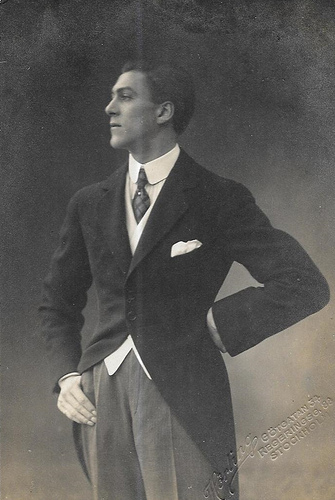
Swedish postcard by Hörling Edition, Stockholm. Collection: Didier Hanson.
Danish film actor and operetta singer Carl Brisson (1893–1958) appeared in 12 films between 1918 and 1935, including two silent films by Alfred Hitchcock. In the Paramount production Murder at the Vanities (1934), he introduced the popular song Cocktails for Two.
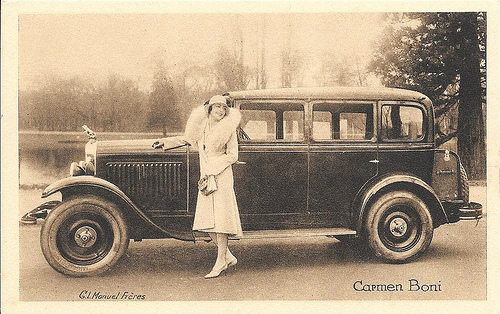
French postcard. Photo: G.L. Manuel Frères. Collection: Didier Hanson.
Italian silent film star Carmen Boni (1901-1963) had a successful career in the Italian cinema of the early 1920s, before moving to Germany where she made one film after another in the late 1920s.
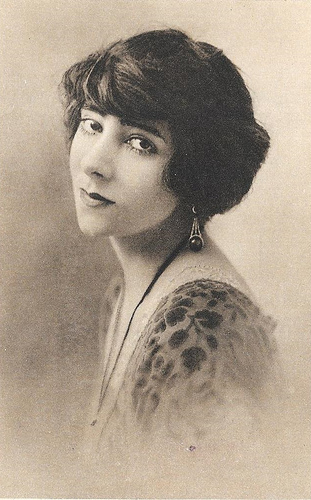
Vintage postcard. Collection: Didier Hanson.
Russian actress Fania Marinoff (1890-1971) lived in the U.S. from childhood and was a prolific performer on Broadway from 1903. She appeared in a few silent films, usually in ethnic or Jewish roles, including The Unsuspected Isles (1915), The Lure of Mammon (1915) and Nedra (1915). She was married to author and photographer Carl Van Vechten.
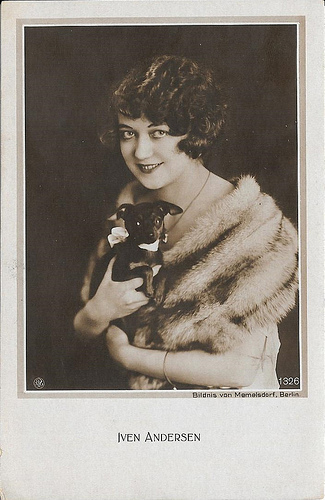
German postcard by NPG, no. 1326. Photo: Memelsdorf, Berlin. Collection: Didier Hanson.
German actress Iven Andersen became known with the Aufklärungsfilm Das Mädchen aus der Opiumhöhle (1918). In the following years she played in several films.
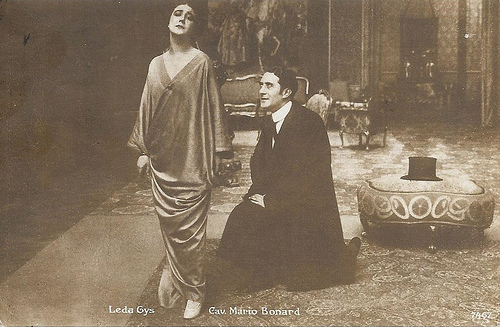
French postcard, no. 7467. Photos: probably a publicity still for La pantomima della morte/The pantomime of death (Mario Caserini, 1915) with Leda Gys and Mario Bonard. Collection: Didier Hanson.
Film diva Leda Gys (1892-1957) starred in ca. 60 dramas, comedies, action thrillers and even westerns of the Italian and Spanish silent cinema. Her claim to fame came with the film Christus (1916), shot in Egypt and Palestine, where Gys performed the Madonna.
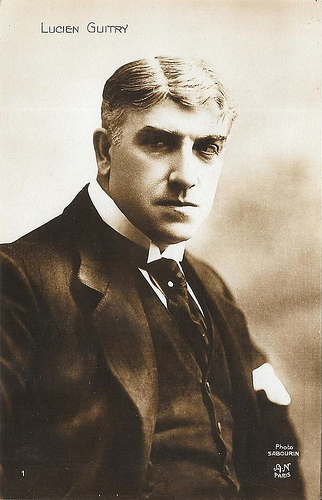
French postcard by A.N., Paris, no. 1. Photo: Sabourin. Collection: Didier Hanson.
Lucien Guitry (1860-1925) was considered the preeminent French actor of his day. For many years, he played opposite Sarah Bernhardt . He also appeared in silent films like Tosca (1908) and Ceux de chez nous (1915). He was married to Jeanne Desclois and Renée de Pont-Jest, and his son was the well known actor-writer-director Sacha Guitry .
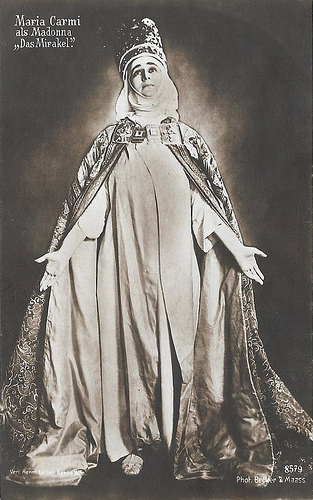
German postcard by Verlag Hermann Leiser, no. 8579. Photo: Becker & Maass. Publicity still for Das Mirakel/The Miracle (Cherry Kearton, Max Reinhardt, 1912) with Maria Carmi as the Madonna.
With her aristocratic air, her severe looks but also her sweet undertones, Italian silent film star and stage actress Maria Carmi (1880-1957) was the cinematic translation of the 19th century Primadonna. Later she became Princess Norina Matchabelli and was co-founder of the perfume company Prince Matchabelli.
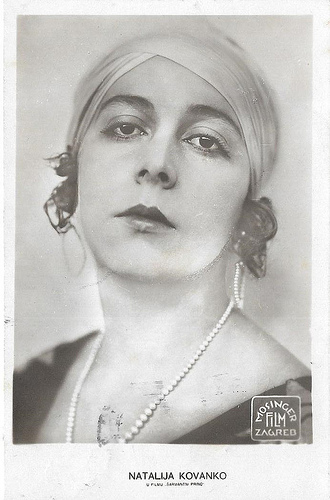
Croatian postcard by Mosinger Film, Zagreb. Photo: publicity still for Le prince charmant/Prince Charming (Viktor Tourjansky, 1925). Collection: Didier Hanson.
Nathalie Kovanko (1899-1967) was a Russian-Ukrainian actress who played in Russian and French silent cinema.
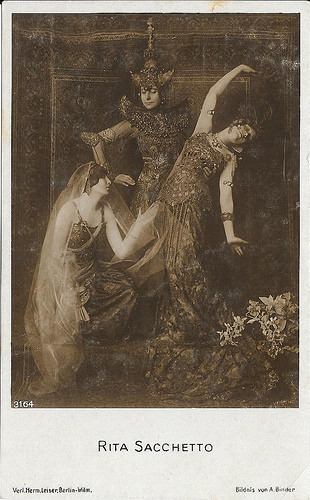
German Postcard by Verlag Hermann Leiser, Berlin, no. 3164. Photo: Alex Binder. Collection: Didier Hanson.
German actress and dancer Rita Sacchetto (1879-1959) was in the 1910s a star of the Danish Nordisk Film Company.
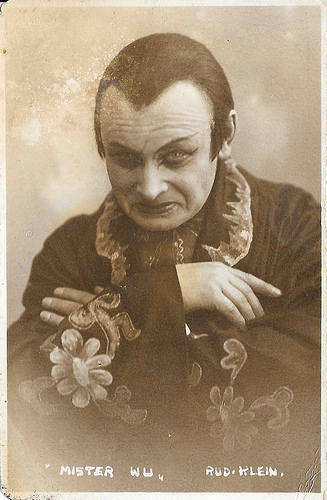
German postcard. Photo: publicity still for the stage production Mister W. Collection: Didier Hanson.
Rudolf Klein-Rogge (1888-1955) is best remembered for his sinister roles in Fritz Lang's silent masterpieces. He played the devilish hypnotist Mabuse in Dr. Mabuse, der Spieler (1925) and the mad scientist Rotwang in Metropolis (1927), but he played more parts in classics of the German cinema.
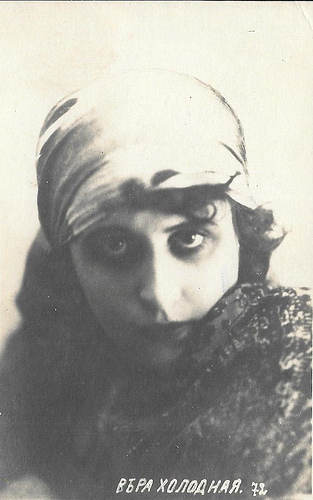
Russian postcard, no. 72. Collection: Didier Hanson.
Vera Kholodnaya (1893-1919) was the first star of the Russian silent cinema. Only 26, the ‘Queen of Screen’ died of the Spanish flu during the pandemic of 1919. Although she worked only three years for the cinema, she must have made between fifty and hundred short films. The Soviet authorities ordered to destroy many of the Kholodnaya features in 1924, and only five of her films still exist.
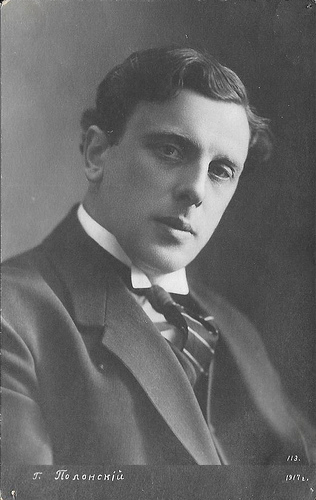
Russian postcard, no. 113, 1917. Collection: Didier Hanson.
Vitold Polonsky (1879-1919) was one of the most popular actors in pre-Revolutionary Russian cinema.
To be continued. Thanks, Didier!

Swedish postcard by Hörling Edition, Stockholm. Collection: Didier Hanson.
Danish film actor and operetta singer Carl Brisson (1893–1958) appeared in 12 films between 1918 and 1935, including two silent films by Alfred Hitchcock. In the Paramount production Murder at the Vanities (1934), he introduced the popular song Cocktails for Two.

French postcard. Photo: G.L. Manuel Frères. Collection: Didier Hanson.
Italian silent film star Carmen Boni (1901-1963) had a successful career in the Italian cinema of the early 1920s, before moving to Germany where she made one film after another in the late 1920s.

Vintage postcard. Collection: Didier Hanson.
Russian actress Fania Marinoff (1890-1971) lived in the U.S. from childhood and was a prolific performer on Broadway from 1903. She appeared in a few silent films, usually in ethnic or Jewish roles, including The Unsuspected Isles (1915), The Lure of Mammon (1915) and Nedra (1915). She was married to author and photographer Carl Van Vechten.

German postcard by NPG, no. 1326. Photo: Memelsdorf, Berlin. Collection: Didier Hanson.
German actress Iven Andersen became known with the Aufklärungsfilm Das Mädchen aus der Opiumhöhle (1918). In the following years she played in several films.

French postcard, no. 7467. Photos: probably a publicity still for La pantomima della morte/The pantomime of death (Mario Caserini, 1915) with Leda Gys and Mario Bonard. Collection: Didier Hanson.
Film diva Leda Gys (1892-1957) starred in ca. 60 dramas, comedies, action thrillers and even westerns of the Italian and Spanish silent cinema. Her claim to fame came with the film Christus (1916), shot in Egypt and Palestine, where Gys performed the Madonna.

French postcard by A.N., Paris, no. 1. Photo: Sabourin. Collection: Didier Hanson.
Lucien Guitry (1860-1925) was considered the preeminent French actor of his day. For many years, he played opposite Sarah Bernhardt . He also appeared in silent films like Tosca (1908) and Ceux de chez nous (1915). He was married to Jeanne Desclois and Renée de Pont-Jest, and his son was the well known actor-writer-director Sacha Guitry .

German postcard by Verlag Hermann Leiser, no. 8579. Photo: Becker & Maass. Publicity still for Das Mirakel/The Miracle (Cherry Kearton, Max Reinhardt, 1912) with Maria Carmi as the Madonna.
With her aristocratic air, her severe looks but also her sweet undertones, Italian silent film star and stage actress Maria Carmi (1880-1957) was the cinematic translation of the 19th century Primadonna. Later she became Princess Norina Matchabelli and was co-founder of the perfume company Prince Matchabelli.

Croatian postcard by Mosinger Film, Zagreb. Photo: publicity still for Le prince charmant/Prince Charming (Viktor Tourjansky, 1925). Collection: Didier Hanson.
Nathalie Kovanko (1899-1967) was a Russian-Ukrainian actress who played in Russian and French silent cinema.

German Postcard by Verlag Hermann Leiser, Berlin, no. 3164. Photo: Alex Binder. Collection: Didier Hanson.
German actress and dancer Rita Sacchetto (1879-1959) was in the 1910s a star of the Danish Nordisk Film Company.

German postcard. Photo: publicity still for the stage production Mister W. Collection: Didier Hanson.
Rudolf Klein-Rogge (1888-1955) is best remembered for his sinister roles in Fritz Lang's silent masterpieces. He played the devilish hypnotist Mabuse in Dr. Mabuse, der Spieler (1925) and the mad scientist Rotwang in Metropolis (1927), but he played more parts in classics of the German cinema.

Russian postcard, no. 72. Collection: Didier Hanson.
Vera Kholodnaya (1893-1919) was the first star of the Russian silent cinema. Only 26, the ‘Queen of Screen’ died of the Spanish flu during the pandemic of 1919. Although she worked only three years for the cinema, she must have made between fifty and hundred short films. The Soviet authorities ordered to destroy many of the Kholodnaya features in 1924, and only five of her films still exist.

Russian postcard, no. 113, 1917. Collection: Didier Hanson.
Vitold Polonsky (1879-1919) was one of the most popular actors in pre-Revolutionary Russian cinema.
To be continued. Thanks, Didier!
Published on September 07, 2015 22:00
September 6, 2015
Betsy Bell
Beautiful blond and blue-eyed German actress Betsy Bell appeared in Italian action films and Spaghetti Westerns of the 1960s and early 1970s.
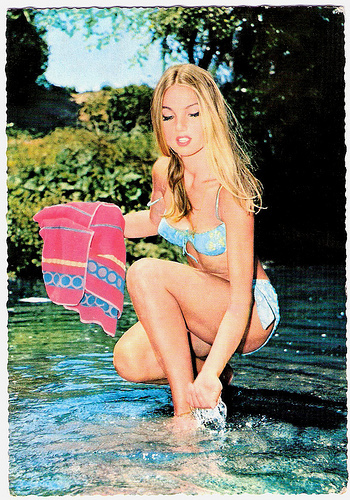
German postcard by Krüger. Sent by mail in the Netherlands in 1965. Photo: Georg Michalke.
Poltergeist
Who was Betsy Bell? At the internet, the best known Betsy Bell was a historical witch who lived in Adams, Tennessee, in the early 19th century. She was called 'The Bell Witch', and became the subject of a poltergeist legend in Southern United States folklore. The legend was the basis of three horror films The Bell Witch Haunting (Ric White, 2004), An American Haunting (Courtney Solomon, 2006) featuring Rachel Hurd-Wood as Betsy Bell, and Bell Witch: The Movie (Shane Marr, 2007). According to Wikipedia , the Bell Witch may have also inspired The Blair Witch Project (Daniel Myrick, Eduardo Sánchez, 1999).
However, the girl at this postcard is not a poltergeist but another Betsy Bell. She came from Hamburg in Germany. Glamour photographer Georg Michalke must have taken her picture in the early 1960s. We adore his sexy pictures for several Krüger postcards of the 1950s and 1960s. Find some more of his photos on the postcards below, but also check out our post on him.
One of the few places we could find some information about this modern Betsy was the International Movie Database , but the IMDb does not mention her birth date nor her birth place. Only that she was born in Germany. So, Betsy Bell was probably a nom de plume and made up by someone with a black sense of humour - to name such a sweet beauty after a horrifying witch.
Betsy Bell was one of these many North-European starlets who traveled to Rome in the 1950s and early 1960s. Rome was the European film Mecca at the time, and in Italy she appeared in seven genre films as blond eye candy. Her first known film was the Italian Peplum Il sepolcro dei re/Cleopatra's Daughter (Fernando Cerchio, 1960) starring Debra Paget as Shila, the daughter of Cleopatra. Betsy played just a small part.
Three years later she was seen in Tototruffa '62 (Camillo Mastrocinque, 1963), one of Italy’s favourite Totò comedies. Again Betsy’s part was only a minor one. She then played a German student in a segment of the anthology film Gli amanti latini/Latin Lovers (Mario Costa, 1965), also with Totò . The anthology film was a popular European genre in the early 1960s, but the attractive blonde would play her most important roles in another popular Euro-film genre of the 1960s, the Spaghetti Western.
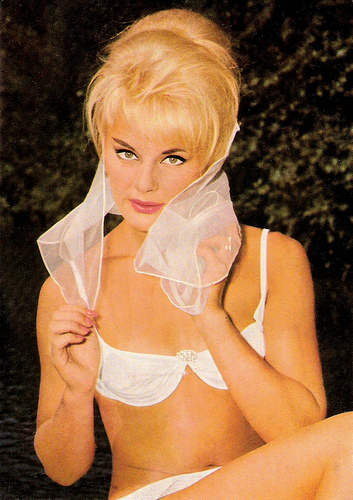
Elke Sommer by Georg Michalke . German postcard by Ufa (Universum-Film Aktiengesellschaft), Berlin-Templehof, no. CK 407. Photo: Georg Michalke/Ufa.
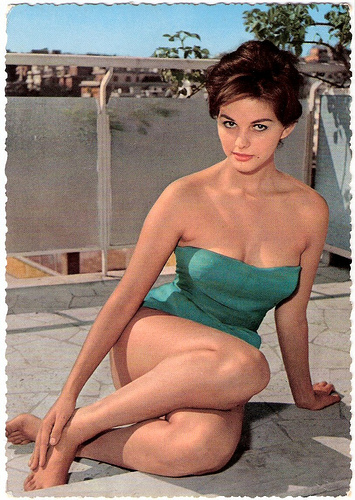
Claudia Cardinale by Georg Michalke . German postcard by Krüger, no. 902/164. Photo: Georg Michalke / Ufa.
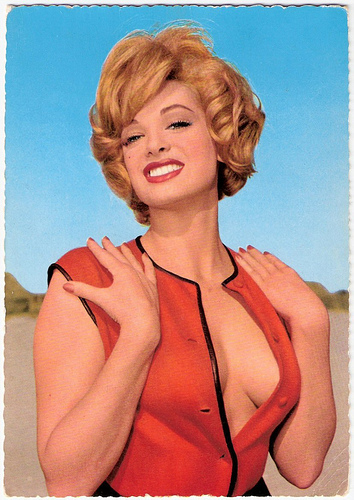
Margaret Lee by Georg Michalke . German postcard by Kruger, no. 902/356. Photo: Georg Michalke.
Blonde Bar-room Chanteuse
Betsy Bell was the leading lady in Quanto costa morire/A Taste of Death (Sergio Merolle, 1968), starring Andrea Giordana, John Ireland and Raymond Pellegrin . This Western tells the tale of a retired sheriff, who is the only one to stand up against a gang of cattle thieves, which terrorizes the people of a snow swept Colorado mountain town.
The result was mediocre, and at IMDb , Van Roberts writes: “A Taste of Death lacks any sense of style and director Sergio Merolle doesn't do anything that has been done before.” In his review Betsy Bell is not even mentioned.
Next she appeared in the war drama Il dito nella piaga/Salt in the Wound/The Liberators (Tonino Ricci, 1969). She again played the female lead and the male stars were Uruguay-born actor George Hilton and German star Klaus Kinski . At IMDb , a Sgt. Slaughter writes: “A highly picked-on, but nearly perfect Italian WW II drama / action piece with a first-rate cast and some fantastic action footage. The film is so good, that it was basically re-made by Enzo Castellari years later as Deadly Mission.” And again there is no mention of the female star.
Bell played a smaller role as a saloon singer in Sartana nella valle degli avvoltoi/Sartana in the Valley of Death (Roberto Mauri, 1970) starring William Berger. Mario Gauci reviews at IMDb : “This is the first entry I've watched in a long-running series of Spaghetti Westerns revolving around the titular figure, played here by William Berger; as such, he displays no particular features that would make him stand out from similar anti-heroes (such as The Man With No Name or Django) and, in fact, is never even referred to by that nickname!” Gauci refers briefly to Bell: “For the record, the song playing over the opening credits King For A Day is quite decent and is even warbled, for no good reason, by a blonde bar-room chanteuse at one point in the film.”
Betsy Bell’s final film was the Spanish-Italian actioner Siete minutos para morir/7 Minutes To Die (Ramón Fernández, 1971). She played the female lead and her co-stars were Paolo Gozlino (aka Paul Stevens) and again, George Hilton. To promote the film, she was (already in June 1966!) on the cover of Hola! , a Spanish magazine which called her 'la bella actriz hamburguesa' (the beautiful actress from Hamburg). She was quoted that her love life more was more important to her than her career.
That explains probably why we could not find more information about Betsy Bell. If you know what happened to Betsy, let us know.
US trailer for Il dito nella piaga/Salt in the Wound (1969). Source: Cronosmantos (YouTube).
Trailer for Sartana nella valle degli avvoltoi/Sartana in the Valley of Death (1970). Source: Lindberg SWDB (YouTube).
Sources: Hola! (Nº 1138 - 18 junio 1966), Wikipedia and .

German postcard by Krüger. Sent by mail in the Netherlands in 1965. Photo: Georg Michalke.
Poltergeist
Who was Betsy Bell? At the internet, the best known Betsy Bell was a historical witch who lived in Adams, Tennessee, in the early 19th century. She was called 'The Bell Witch', and became the subject of a poltergeist legend in Southern United States folklore. The legend was the basis of three horror films The Bell Witch Haunting (Ric White, 2004), An American Haunting (Courtney Solomon, 2006) featuring Rachel Hurd-Wood as Betsy Bell, and Bell Witch: The Movie (Shane Marr, 2007). According to Wikipedia , the Bell Witch may have also inspired The Blair Witch Project (Daniel Myrick, Eduardo Sánchez, 1999).
However, the girl at this postcard is not a poltergeist but another Betsy Bell. She came from Hamburg in Germany. Glamour photographer Georg Michalke must have taken her picture in the early 1960s. We adore his sexy pictures for several Krüger postcards of the 1950s and 1960s. Find some more of his photos on the postcards below, but also check out our post on him.
One of the few places we could find some information about this modern Betsy was the International Movie Database , but the IMDb does not mention her birth date nor her birth place. Only that she was born in Germany. So, Betsy Bell was probably a nom de plume and made up by someone with a black sense of humour - to name such a sweet beauty after a horrifying witch.
Betsy Bell was one of these many North-European starlets who traveled to Rome in the 1950s and early 1960s. Rome was the European film Mecca at the time, and in Italy she appeared in seven genre films as blond eye candy. Her first known film was the Italian Peplum Il sepolcro dei re/Cleopatra's Daughter (Fernando Cerchio, 1960) starring Debra Paget as Shila, the daughter of Cleopatra. Betsy played just a small part.
Three years later she was seen in Tototruffa '62 (Camillo Mastrocinque, 1963), one of Italy’s favourite Totò comedies. Again Betsy’s part was only a minor one. She then played a German student in a segment of the anthology film Gli amanti latini/Latin Lovers (Mario Costa, 1965), also with Totò . The anthology film was a popular European genre in the early 1960s, but the attractive blonde would play her most important roles in another popular Euro-film genre of the 1960s, the Spaghetti Western.

Elke Sommer by Georg Michalke . German postcard by Ufa (Universum-Film Aktiengesellschaft), Berlin-Templehof, no. CK 407. Photo: Georg Michalke/Ufa.

Claudia Cardinale by Georg Michalke . German postcard by Krüger, no. 902/164. Photo: Georg Michalke / Ufa.

Margaret Lee by Georg Michalke . German postcard by Kruger, no. 902/356. Photo: Georg Michalke.
Blonde Bar-room Chanteuse
Betsy Bell was the leading lady in Quanto costa morire/A Taste of Death (Sergio Merolle, 1968), starring Andrea Giordana, John Ireland and Raymond Pellegrin . This Western tells the tale of a retired sheriff, who is the only one to stand up against a gang of cattle thieves, which terrorizes the people of a snow swept Colorado mountain town.
The result was mediocre, and at IMDb , Van Roberts writes: “A Taste of Death lacks any sense of style and director Sergio Merolle doesn't do anything that has been done before.” In his review Betsy Bell is not even mentioned.
Next she appeared in the war drama Il dito nella piaga/Salt in the Wound/The Liberators (Tonino Ricci, 1969). She again played the female lead and the male stars were Uruguay-born actor George Hilton and German star Klaus Kinski . At IMDb , a Sgt. Slaughter writes: “A highly picked-on, but nearly perfect Italian WW II drama / action piece with a first-rate cast and some fantastic action footage. The film is so good, that it was basically re-made by Enzo Castellari years later as Deadly Mission.” And again there is no mention of the female star.
Bell played a smaller role as a saloon singer in Sartana nella valle degli avvoltoi/Sartana in the Valley of Death (Roberto Mauri, 1970) starring William Berger. Mario Gauci reviews at IMDb : “This is the first entry I've watched in a long-running series of Spaghetti Westerns revolving around the titular figure, played here by William Berger; as such, he displays no particular features that would make him stand out from similar anti-heroes (such as The Man With No Name or Django) and, in fact, is never even referred to by that nickname!” Gauci refers briefly to Bell: “For the record, the song playing over the opening credits King For A Day is quite decent and is even warbled, for no good reason, by a blonde bar-room chanteuse at one point in the film.”
Betsy Bell’s final film was the Spanish-Italian actioner Siete minutos para morir/7 Minutes To Die (Ramón Fernández, 1971). She played the female lead and her co-stars were Paolo Gozlino (aka Paul Stevens) and again, George Hilton. To promote the film, she was (already in June 1966!) on the cover of Hola! , a Spanish magazine which called her 'la bella actriz hamburguesa' (the beautiful actress from Hamburg). She was quoted that her love life more was more important to her than her career.
That explains probably why we could not find more information about Betsy Bell. If you know what happened to Betsy, let us know.
US trailer for Il dito nella piaga/Salt in the Wound (1969). Source: Cronosmantos (YouTube).
Trailer for Sartana nella valle degli avvoltoi/Sartana in the Valley of Death (1970). Source: Lindberg SWDB (YouTube).
Sources: Hola! (Nº 1138 - 18 junio 1966), Wikipedia and .
Published on September 06, 2015 22:00
Paul van Yperen's Blog
- Paul van Yperen's profile
- 13 followers
Paul van Yperen isn't a Goodreads Author
(yet),
but they
do have a blog,
so here are some recent posts imported from
their feed.



